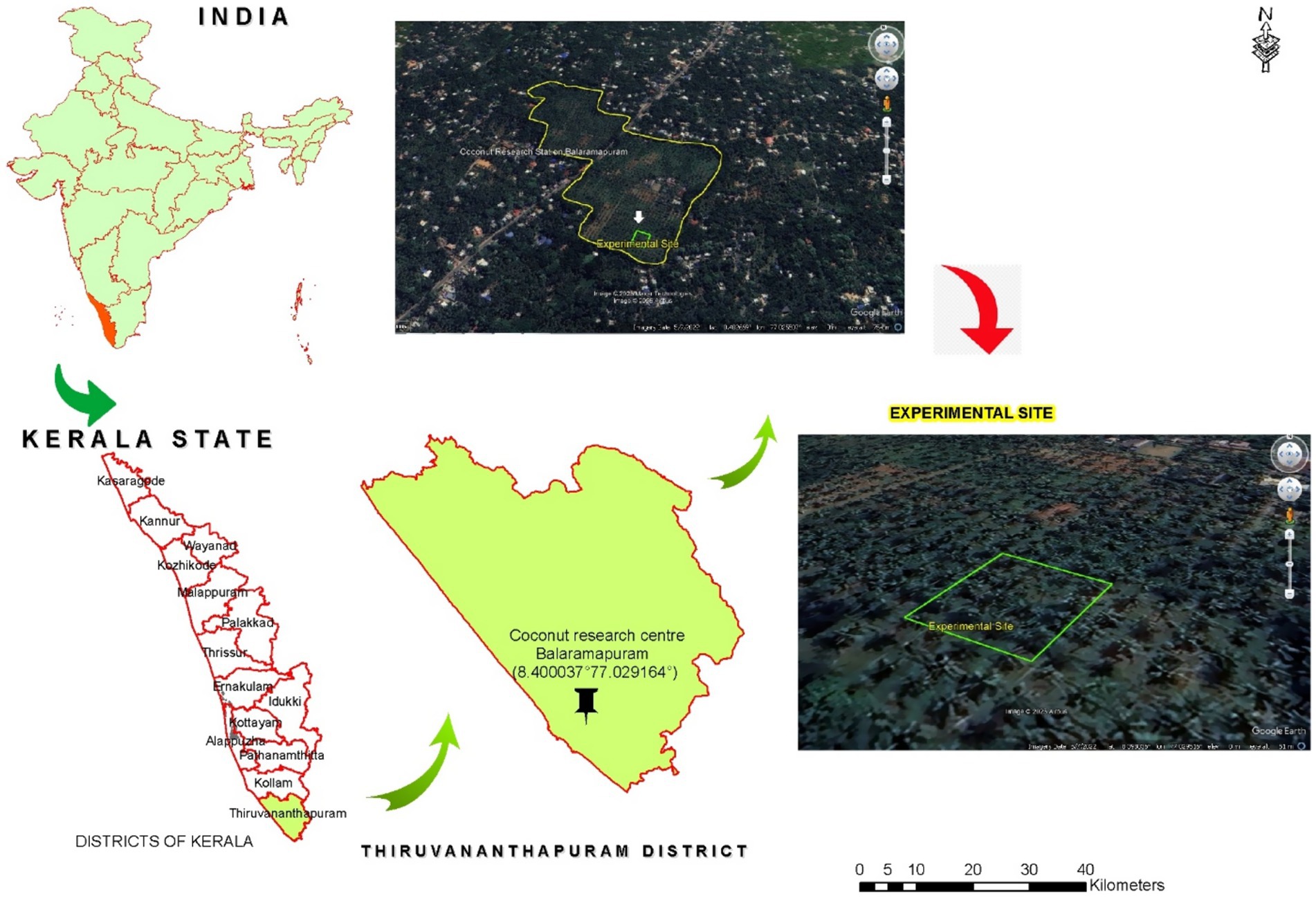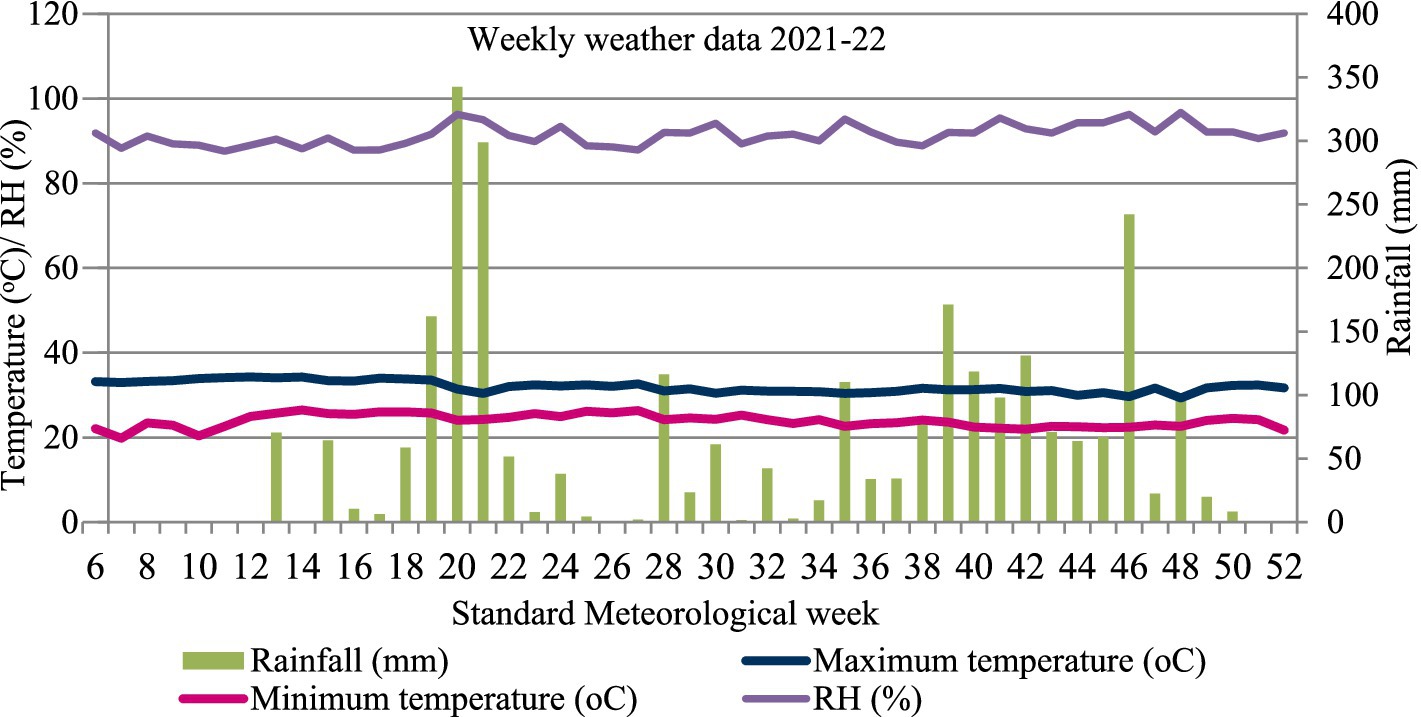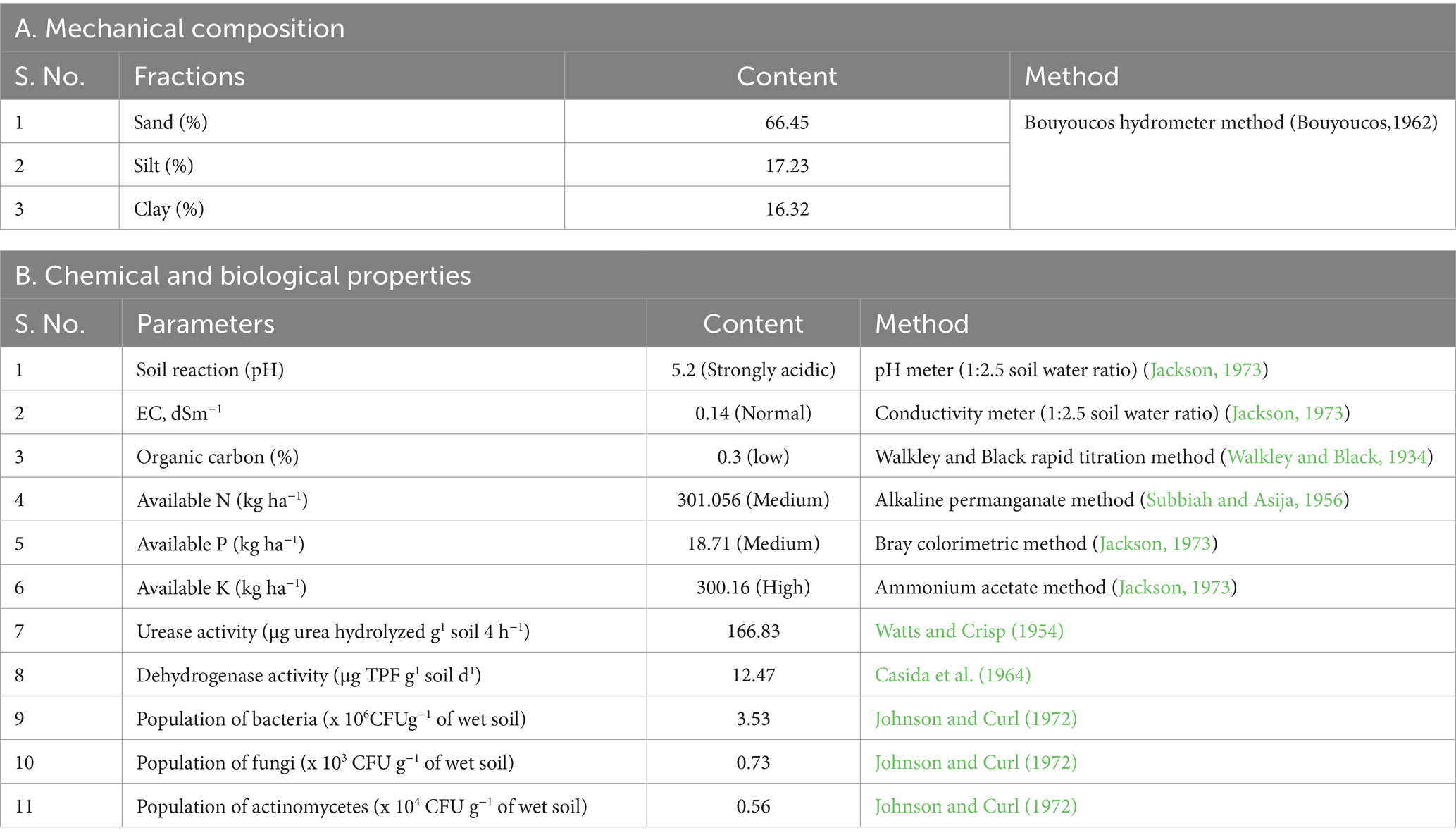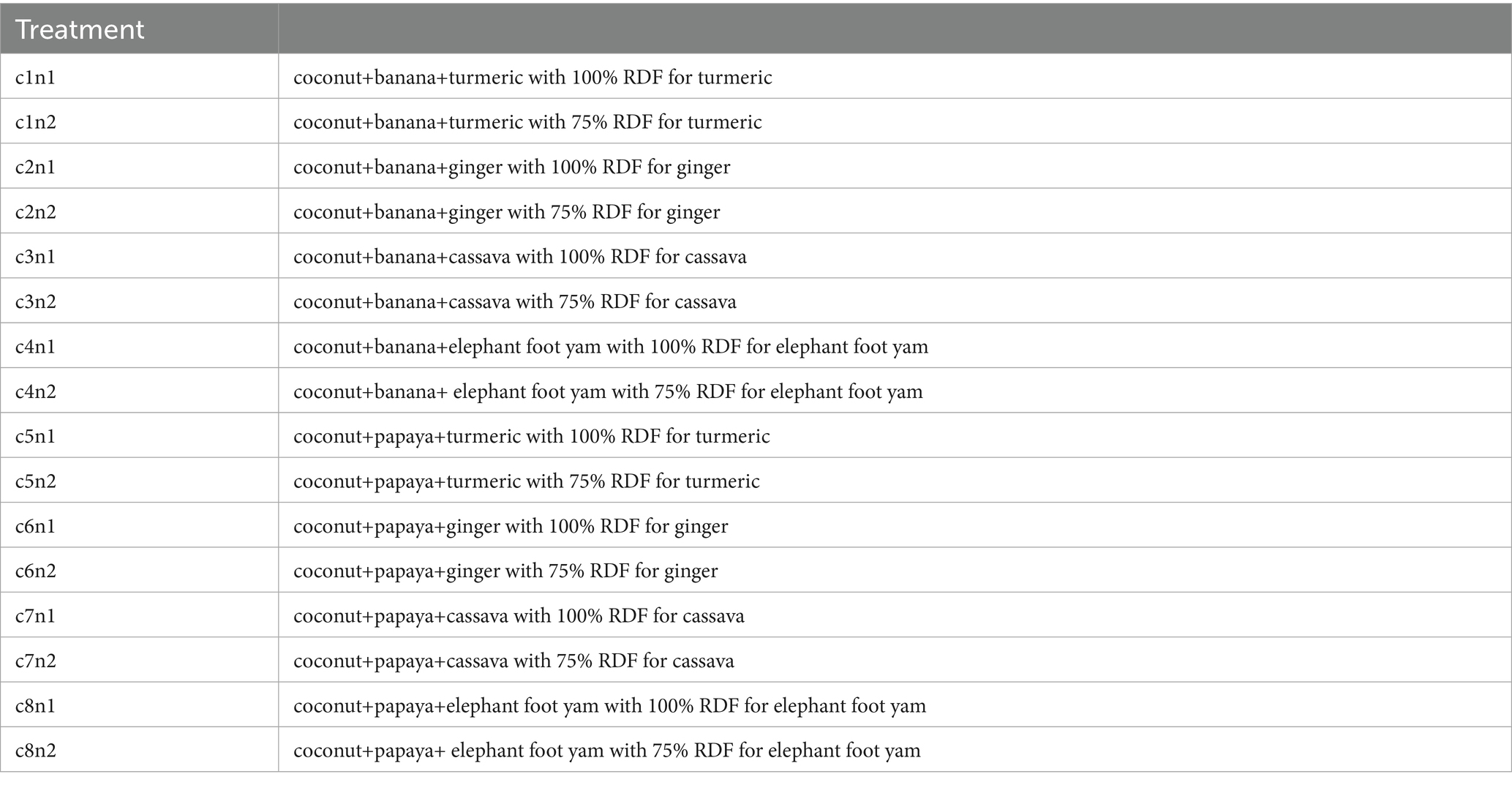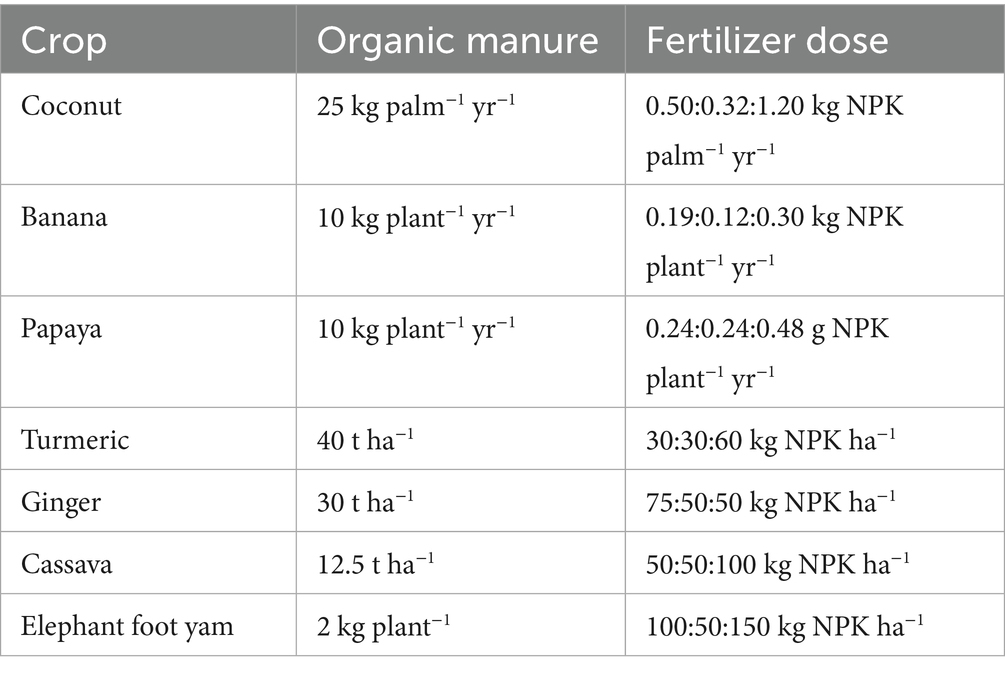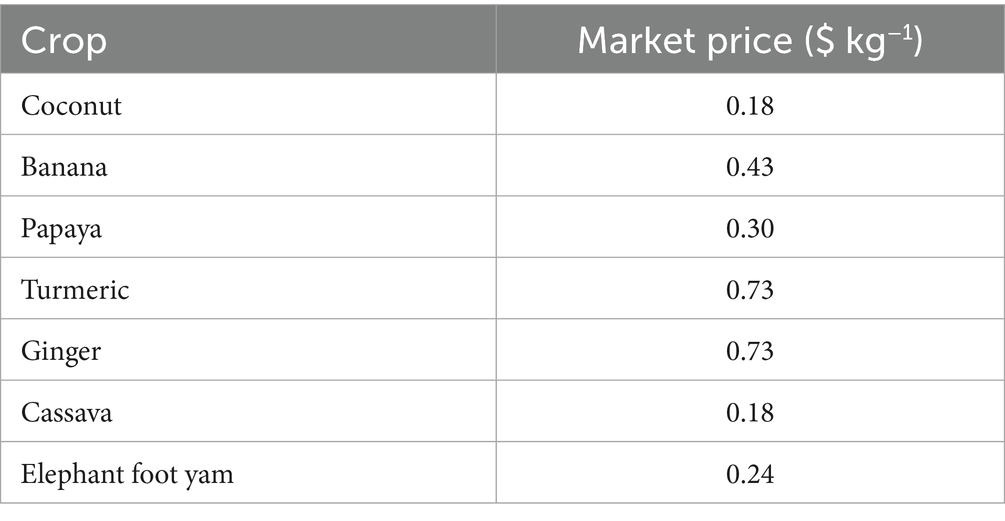- 1Department of Agronomy, College of Agriculture, Kerala Agricultural University, Thiruvananthapuram, India
- 2Department of Organic Agriculture, College of Agriculture, Kerala Agricultural University, Thiruvananthapuram, India
- 3OFR Centre, ORARS, Kerala Agricultural University, Alappuzha, India
- 4Department of Plant Pathology, College of Agriculture, Kerala Agricultural University, Thiruvananthapuram, India
- 5Natural Resource Management Section, ICAR-Central Coastal Agricultural Research Institute, Old Goa, India
- 6Department of Ecology and Environmental Science, Assam University, Silchar, India
Coconut has become the backbone of various agricultural practices in different tracts of Kerala ranging from the sea shores to hilly areas. Kerala was first in area and production earlier but is backward today due to land degradation, industrialization and infrastructure development. This affected the coconut growers and they are facing challenges to cultivate it on a remunerative basis. In this context, there is a need to intensify crop production from the available land area under coconut plantations. Therefore, the current study aims to prove how crop intensification through intercropping in coconut gardens alters system yield and profitability, as well as the soil properties including soil fertility, microbial biomass, and carbon stock. The experiment was conducted at Coconut Research Station, Balaramapuram, Kerala, India, during 2021–2022 in a 60-year-old coconut plantation intercropped with banana, papaya, turmeric, ginger, cassava and elephant foot yam. A randomized complete block design (RCBD) was used to compare the different crop combinations and nutrient rates [100 and 75% Recommended Dose of Fertilizer (RDF)] for the floor crop. Coconut intercropped with banana and turmeric with 75% RDF for turmeric (c1n2) resulted in the highest bunch yield of 138.78 kg unit−1, coconut equivalent yield (NEY) of 475 nuts unit−1 yr−1, and system productivity of 736 nuts unit−1 yr−1. The system also revealed higher economic efficiency, with gross and net returns of $23,852 ha−1 yr−1 and $13,528 ha−1 yr−1 respectively. The soil enzymatic activity, microbial population and soil organic carbon (SOC) were also highest in the system including banana. This study has brought out the fact that proper intercropping and utilization of nutrient resources could improve the yield and the long-term sustainability of coconut farming in Kerala significantly. The results demonstrate that intercropping of coconut with banana and turmeric, along with 100% RDF for coconut and banana and 75% RDF for turmeric, has significantly increased the NEY, system productivity, economic returns, and soil organic carbon (SOC). These findings provide a model for multistoried integration with compatible crops, especially in an aged coconut garden. Further, this study can also be extended for a few more years to analyse the impact on climate and market scenarios.
1 Introduction
Coconut (Cocos nucifera L., Arecaceae), the predominant multifarious crop, occupies the largest area of 7,60,000 hectares in Kerala, India in 2022–23 (CDB, 2023). It is cultivated in the lowland, midland, and highland slopes being a significant part of Kerala’s agriculture emphasizing low western seaboard, valleys, and hills (Gadhe and Mathur, 2018). There was an increase in the area from 2007 to 2012, and it followed a stabilized pattern up to 2019. But from 2019 to 2022, the area tends to decline by 0.4% (CDB, 2023). Even though it is adaptable to various agroclimatic regions across the country, the area under this plantation crop has been declining over the years due to the effects of urbanization and changes in the national and global economy. The shrinkage in area, coupled with soil degradation, improper nutrient management, and suboptimal agricultural practices in the existing plantation, has drastically reduced productivity. These trends point to the fact that constant monitoring as well as appropriate engagements are required to maintain the coconut’s agricultural value and its related ethnopharmacological uses in Kerala.
In this state of concerns, with the available land area under coconut, there is a need to intensify production in coconut gardens, to achieve the country’s food requirements. Fortuitously, coconut is highly amenable to crop intensification (Maheswarappa et al., 2007), which remains committed to the land for decades with a long gestation period (Mensah et al., 2011). When planted as a monocrop, it cannot fully utilize all the available natural resources effectively due to its wider spacing (7.5 m x 7.5 m) (Maheswarappa et al., 2000). The canopy spread was only 22.3% of the land area and interception of solar radiation is about 50%. Moreover, the lateral root spread is confined to a 2 m radius and 30–120 cm depth of the soil in palms aged more than 25 years (Thomas et al., 2018) which makes this perennial a suitable crop for intercropping. This can be done by growing crops that are compatible like spices, fruits, tuber, vegetable crops etc., (Shinde et al., 2020). Intercropping in a coconut garden can serve as a complementary system that supports both the intercrop and the maincrop. Nevertheless, this potential of coconut is often lost when the intercrops are not adequately fertilized with the concept of utilization of the existing nutrients available in the soil. This has to be changed, intercropping with compatible crops coupled with adequate nutrient management will eventually reduce vulnerability and increase farm income as well as enhance soil health by increasing the level of biological diversity (Shinde et al., 2020).
Meerabai et al. (2000) reported that coconut intercropped with turmeric fertilized with 120:120:2:10 kg N, K2O, B, Zn ha−1 yielded 19.8 t ha−1 of turmeric. Ravi et al. (2011a) suggested that elephant foot yam required only FYM 12.5 t ha−1 and NPK dose of 25:30:33 kg ha−1 to produce 13 t ha−1 corm yield in coconut.
The impact of intercrops on the yield of coconut was also evident in several studies. Coconut+ pepper intercropping system produced a higher nut yield (12,575 nuts ha−1) than coconut monocropping (9,784 nuts ha−1) (Ghosh, 2009). Tuber crops also enhanced the yield of coconut. Mensah et al. (2011) showed that nut yield from coconut+ cassava intercropping system was higher (1,172 nuts ha−1) than coconut monocrop system (480 nuts ha−1). It was clear, as demonstrated by Padma et al. (2018), that the yield of coconut was high when intercropped with medicinal plants like patchouli and palmarosa. This suggests that the inter-space planting with annual and perennial crops also contributed to an increase in general nut yield in the subsequent years. Intercropping maximally optimizes the use of growth resources which normally would not be properly utilized. This optimum utilization of resources leads to improved coconut yield as well as the system productivity of an intercropped coconut garden (Brooker et al., 2015). All-India Co-ordinated Research Project (AICRP) on Palms reports that the High-Density Multi-Species Cropping System (HDMSCS) technology has enhanced coconut yield and system productivity. A precise measure of the improvement in the productivity of a particular system is given by the nut equivalent yield (NEY) which amalgamates all component yields in an intercropping system by converting them into yield of the nut equivalent crop at the prevailing market prices. Ghosh and Bandopadhyay (2011) revealed that coconut + black pepper + pineapple-based HDMSCS had the highest NEY (27,443 nuts ha−1 yr−1) than that of coconut monocrop (11,088 nuts ha−1). Flower crops can also be intercropped in coconut gardens as reported by Nath et al. (2019), who suggested that coconut + gerbera system recorded the highest NEY of 48,920 nuts ha−1 yr−1 and coconut + tuberose yielded 42,717 nuts ha−1 yr−1.
Coconut-based farming systems also allow more soil biological activity than monocultures according to Central Plantation Crops Research Institute (CPCRI, 2014). It was confirmed by Nath and Deka (2010) that intercropping not only boosts the nut yield but also raises the rate of microbial decomposition in soil. For example, coconut-based intercropping with black pepper and banana as well as elephant foot yam revealed a higher fungal and bacterial load of 3.33 × 105 CFU g−1 of dry soil and 12.30 × 105 CFU g−1 of dry soil, respectively. Ghosh and Bandopadhyay (2011) compared the stock of carbon in the soils under coconut+ nutmeg+ cinnamon+ banana+ pineapple intercropping system which was found to be as high as 42.3 t ha−1 while the monoculture coconut established soil carbon stock of 28.4 t ha−1 of the soil. Shinde et al. (2021b) took further analysis to document that such systems made soils less acidic by altering the pH, also impacting the carbon richness and nutrient functionality. Moreover, Maheswarappa et al. (2007) also noted enhanced status of physical and chemical parameters of soil in the root zones and interspace of coconut gardens with fodder grasses like guinea grass and Hybrid Napier.
Farmers in Kerala have been practicing intercropping in coconut gardens for years but maintaining productivity (Sambhu, 2021; Narmadha et al., 2022) and soil nutrient status was always a concern (Nair et al., 2018; Sudhalakshmi, 2021). Although many studies were conducted on coconut-based intercropping systems, most of them focus on either a single intercrop or do not consider nutrient optimization, especially in an aged coconut palm. The present study investigates the interaction effects of various crop combinations (banana, papaya, turmeric, ginger, cassava and elephant foot yam) in multilevel crop structures optimized for coconut gardens. Alongside, this research breaks through the customized nutrient management practices that can be exclusively adopted for a multitier coconut garden. Additionally, this study focuses on enhancing system productivity, profitability, and soil health through an integrated approach.
2 Materials and methods
2.1 Experimental site and soil information
The different cropping system models in the present study were developed at Coconut Research Station (CRS), Balaramapuram, Kerala, India, which is located at 8° 22′55” North latitude and 77° 1′47″East longitude and an altitude of 9 m above MSL (Figure 1). The prevailing climate throughout the experiment was characterized as warm and humid. Daily weather data, including rainfall, maximum and minimum temperature, relative humidity (RH), and evaporation, were collected during the study period from the meteorological observatory of CRS. The mean maximum and minimum temperature recorded during the crop period from 2021 to 22 were 31.96°C and 23.86°C, respectively, and a total rainfall of 2,805 mm was received in 161 days (Figure 2). The soil at the experimental site was characterized by red color and sandy loam in texture. The soil was acidic with a pH of 5.2. and have an electrical conductivity (EC) of 0.14 dSm−1. The soil organic carbon (SOC) content was 0.3% before the start of the experiment. The available nutrient levels of the soil before the start of the experiment were 301.05 kg ha−1 nitrogen (N), 18.17 kg ha−1 phosphorus (P), and 300.16 kg ha−1 potassium (K). The soil was well-drained and consisting 66.45% sand, 17.23% silt, and 16.32% clay (Table 1).
2.2 Experimental details
The study was conducted in a 60-year-old coconut plantation with a planting configuration of 7.5 m × 7.5 m, resulting in a light transmission rate of 70%. Each interrow space, measuring 56.25 m2 and encompassing four coconut palms, was designated as a single experimental unit. The experiment was carried out in a randomized block design, integrating six different intercrops: banana, papaya, turmeric, ginger, cassava, and elephant foot yam (Table 2). These intercrops were strategically arranged in different layers (Table 2) based on specific treatment plans (Table 3). So, one unit contains three different crops, coconut (main crop) + one-second storey crop (banana or papaya) + one-floor crop (ginger/turmeric/cassava/elephant foot yam) depending on the treatments (Table 3). In each treatment, banana or papaya was planted 2 m from the base of each palm. Therefore each unit contained three rows of banana or papaya. Floor crops such as turmeric, ginger, cassava, and elephant foot yam were raised in the interspaces between the three rows of banana or papaya. Turmeric and ginger are cultivated in beds, cassava on mounds, and elephant foot yam in pits. The intercrops were strategically placed to receive the maximum incident light (Figures 3a,b).
Farmyard manure (FYM) and chemical fertilizers such as urea, rajphos and potash were used as sources of nutrients for the crops. Coconut, banana, and papaya received the RDF based on the package of practices (POP) recommendations of Kerala Agricultural University (KAU, 2016). The floor crops, viz., ginger, turmeric, cassava, and elephant foot yam, were fertilized with the full dose of their recommended NPK dose and 75% RDF according to their respective treatment plans (Table 4).
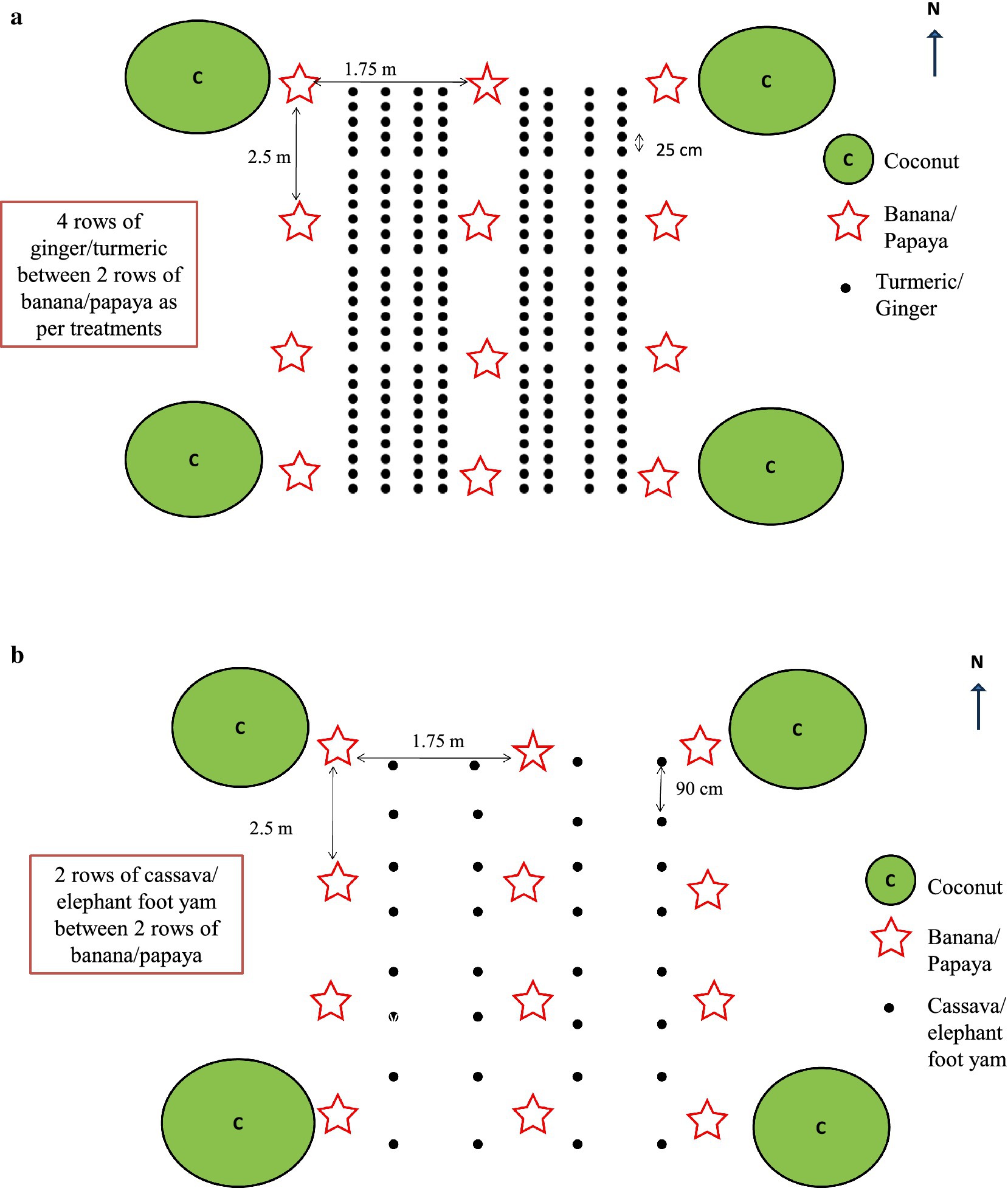
Figure 3. (a) Layout of coconut + banana/papaya + turmeric/ginger. (b) Layout of coconut + banana/papaya + cassava/elephant foot yam.
2.3 Yield
The intercrop yields were assessed individually after harvest by measuring the weight of the produce from each unit area of 56.25 m2. The yield was determined for bananas by weighing each bunch during the harvesting stage, including the stem section up to the first visible scar, from all 12 banana plants in the plot, and expressed as kg unit−1. Similarly, the weights of all the fruits harvested from the 12 papaya plants in each unit were recorded and expressed as kg unit−1 to determine the papaya yield. The yields of turmeric and ginger rhizomes from each treatment were also measured separately and are expressed in kg unit−1. Additionally, the total weight of the tubers and corms from each treatment was recorded and expressed in kg unit−1.
The coconut equivalent yield (NEY) was calculated using the formula that Kumar et al. (2017) used and expressed in nuts unit−1 yr−1.
Nut equivalent yield (NEY) = (Yield of intercrops (kg unit−1) × Price of intercrop)/Price of coconut.
Similarly, the system productivity was calculated using the formula of Kumar et al. (2017) and expressed in nuts unit−1 yr−1. The coconut yield was recorded from the four palms within each unit.
2.4 Uptake
The banana plant samples were categorized into pseudostems, rhizomes, leaves, fruits, and peduncles. Papaya and cassava samples were then divided into stems, leaves, and fruits/tubers of each plant. The turmeric, ginger, and elephant foot yam plant samples were partitioned into aerial shoot and rhizome/corm portions. Samples collected at harvest were conditioned in a hot air oven at 65 ± 5°C until the samples’ constant weights were recorded. The dried samples were milled, passed through a 0.5 mm nylon mesh, and analyzed for nitrogen (N), phosphorus (P), and potassium (K) after digesting them in concentrated sulfuric acid. The total nitrogen (TN), total phosphorus (TP) and total potassium (TK) content (%) was ascertained by using the method described by Jackson (1973). The NPK content was multiplied with their respective dry matter to obtain the nutrient uptake and expressed in kg ha−1.
2.5 Economics
For the economics of cultivation, gross return, cost of cultivation and net return, were calculated. The gross return was found by totalizing the produce yield per unit based on kilograms per unit of production. Then multiplied by the market price per unit to arrive at the gross return being realized from the occasioned harvest. It was possible to identify all the inputs used when growing the crops including seeds, fertilizers, pesticides, herbicides, water, fuel, labor and machinery etc. The use of each input was measured and the corresponding cost of each input was determined. Last but not least; the usage of each input was also multiplied by to cost of that input to find out the final cultivation cost. The benefit–cost ratio (BCR)was arrived at through a simple calculation between the gross return and the total cost of cultivation.
2.6 Soil quality indicators
Soil parameters were analysed both before (Table 1) and after the experiment. Soil urease was estimated by using Watts and Crisp’s (1954) method and presented as μg Urea-N hydrolyzed g−1 soil in a 4 h cycle. Dehydrogenase activity was measured based on the method designed by Casida et al. (1964), and enzyme activity was presented in μg Triphenylformazan (TPF) g−1 soil d−1. Populations by group (bacteria, fungi, and actinomycetes) were assessed using the serial dilution plate technique of Johnson and Curl (1972) and are presented as Colony Forming Unit g−1 (CFU g−1) of wet soil. The soil pH and electrical conductivity (EC) were measured in a 1:2.5 wet composite soil: water mixture (Jackson, 1973). Soil organic carbon was determined using Walkley and Black’s (1934) titration method and expressed in percentage. Chemical nitrogen (N) being available was estimated using Subbiah and Asija (1956) methods and transformed into kilograms per hectare. Available phosphorus (P) and potassium (K) analyses were done within the approach presented by Jackson (1973) and are given in kg ha−1.
2.7 Statistical analyses
The experimental data were analyzed statistically via the variance analysis technique (ANOVA) suggested by Panse and Sukhatme (1985), which was applied to the RBD. The significance was tested via the F test (Snedecor and Cochran, 1967), and critical differences (CDs) were calculated at the 5 % probability level wherever the treatments were found to be significant.
3 Results
3.1 System productivity
3.1.1 Intercrop yield
The crop combinations and floor crop nutrition influenced yield in the intercrops as presented in Table 5. Further, the highest bunch yield of banana per unit was noted in coconut+banana+turmeric, with 75% RDF for turmeric (c1n2) (138.78 kg unit−1), followed by coconut + banana + turmeric with 100% RDF for turmeric (c1n1). The lowest bunch yield of banana was observed in coconut + banana + elephant foot yam treatments, whereby elephant foot yam received 75% RDF for c4n2 (89.18 kg unit−1). The maximum fruit yield of papaya was 95.59 kg unit−1 by c8n2 treatment, which includes coconut +papaya+ elephant foot yam by using 75% RDF for elephant foot yam. It was also observed that c7n1 treatment, which included coconut + papaya + cassava with 100% RDF for cassava, recorded the minimum papaya fruit yield, 46.23 kg unit−1.
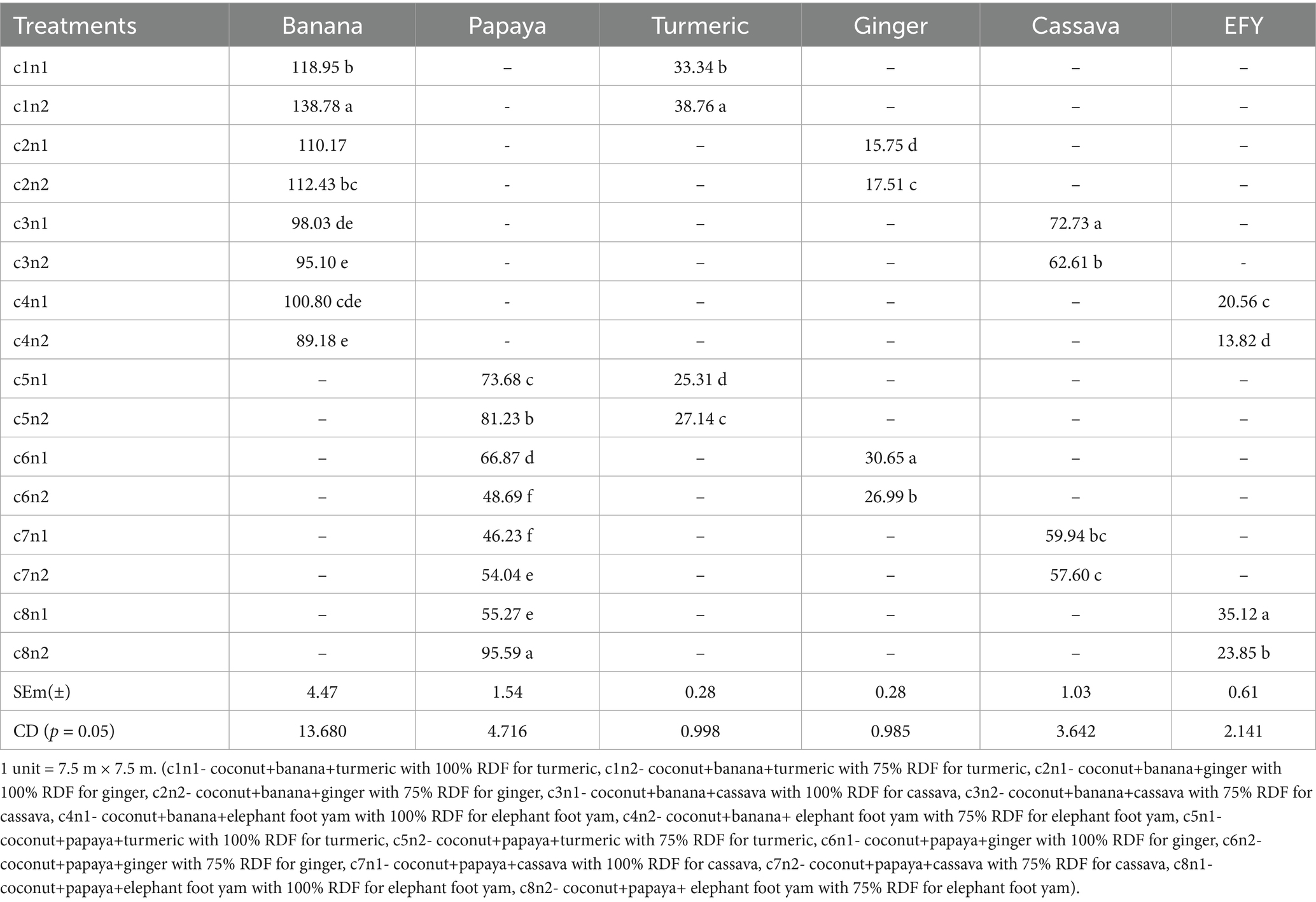
Table 5. Intercrop yield in coconut-based multistoried cropping systems as influenced by crop combinations and floor crop nutrient dose, kg unit−1.
The highest rhizome yield of turmeric was recorded in coconut+ banana+ turmeric with 75% RDF for turmeric (38.76 kg unit−1); in coconut+ banana+ turmeric with 100% RDF for turmeric (c1n1) the rhizome yield was 33.34 kg unit−1 and the lowest rhizome yield (25.31 kg unit−1) was noticed in coconut+ papaya+ turmeric with 100% RDF for turmeric (c5n1). For ginger, the combination of coconut + papaya + ginger with 100% RDF for ginger (c6n1) had the highest rhizome yield of 30.65 kg unit−1. Among the treatments tested, the coconut+banana+ginger with 100% RDF for ginger (c2n1) produced the lowest rhizome yield of ginger (15.75 kg unit−1). The highest tuber yield for the treatment coconut + banana + cassava with 100% RDF for cassava (c3n1) was 72.73 kg unit−1 followed by the treatment coconut + banana + cassava with 75% RDF for cassava (c3n2). The lowest yield was recorded in coconut+papaya+cassava, and the cassava received 75% RDF for cassava, c7n2 (57.60 kg unit−1). The highest corm yield was observed in coconut and papaya intercropped with elephant foot yam at 100% RDF (c8n1) 35.12 kg unit−1, followed by coconut+papaya+elephant foot yam with 75% RDF for elephant foot yam (c8n2). Nevertheless, with elephant foot yam, intercrops of coconut and banana at 75% RDF for cassava (c4n2) yielded the lowest tuber yield, 13.82 kg unit−1. This means that there was an increased yield by maximizing the crop and optimum nutrient combinations, results which supported the hypothesis. Thus, in general, such combinations as c1n2 for bananas, c8n2 for papayas, c1n2 for turmeric, c6n1 for ginger, c3n1 for cassava, and c8n1 for elephant foot yam provided the highest yields.
3.1.2 Coconut equivalent yield and system productivity
Table 6 presents the coconut equivalent yield and system productivity data collected at the harvesting stage of the crops, showing a significant interaction between the crop combinations and the level of crop nutrition. In particular, coconut, banana, and turmeric intercropped with 75% RDF (c1n2) provided significant results. The results of this treatment produced the highest NEY of 475 nuts unit−1 yr−1 and the highest system productivity of 736 nuts unit−1 yr−1. Coconut + papaya + cassava with 100% RDF shows the lowest NEY (137 nuts unit−1 yr−1) and the system productivity (380 nuts unit−1 yr−1). The findings of these results highlight the important role of crop selection and nutrient management strategies in the yield and productivity maximization of the coconut-based intercropping system. In designing cropping systems, it is shown that a trade can be made between high-performing, sustainable crops such as bananas, and nutrient levels in subsequent crops of 75% RDF (N2) v/s 100% RDF.
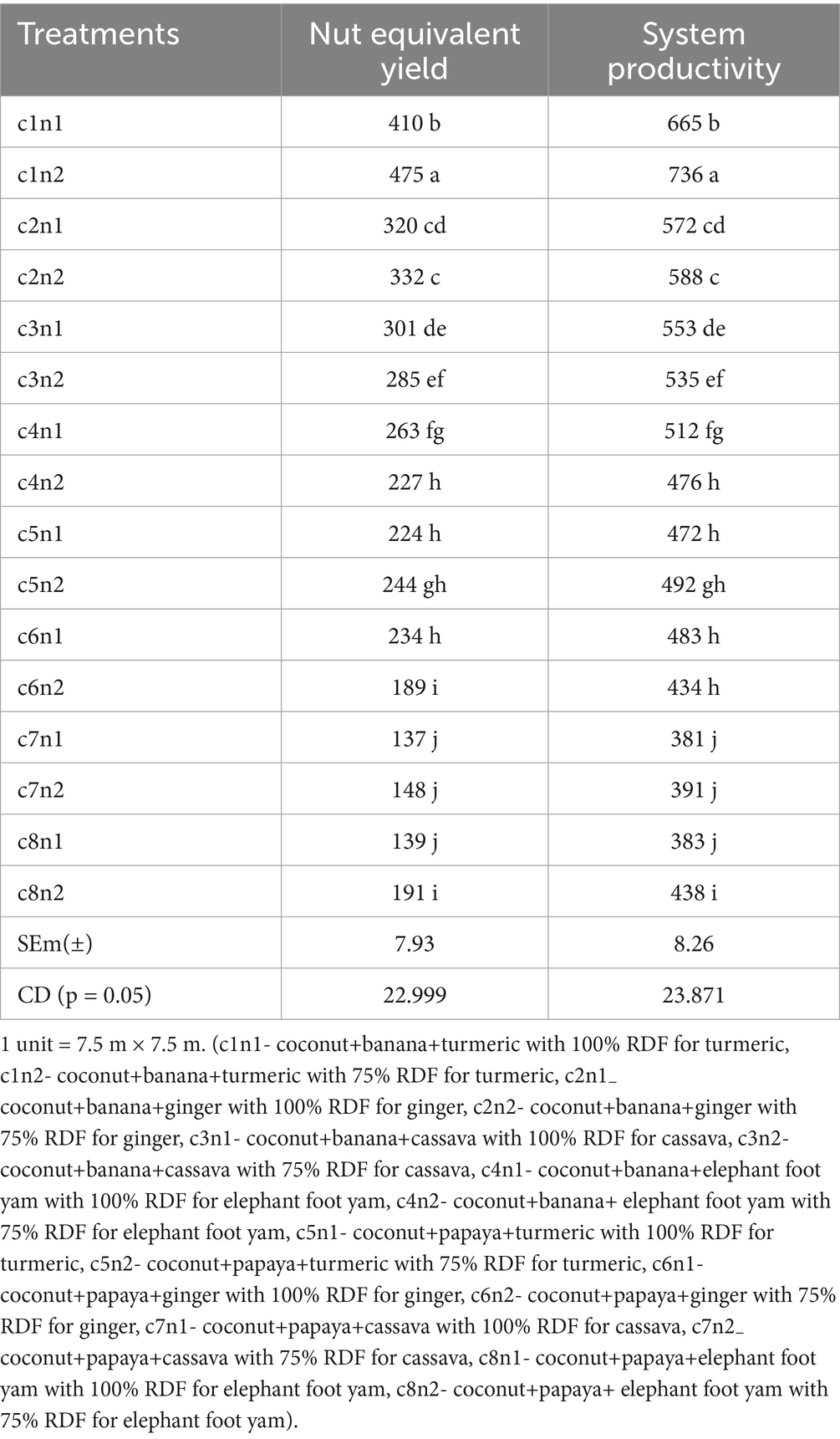
Table 6. Coconut equivalent yield and system productivity in coconut-based multistoried cropping systems as influenced by crop combinations and floor crop nutrient doses, nuts unit−1 yr−1.
3.1.3 NPK uptake
There was a significant effect of crop combination on the interaction of NPK uptake on the crops in the system, as shown in Table 7. Combining coconut + banana + turmeric with 75% RDF for turmeric (c1n2) resulted in the highest N uptake (395.81 kg ha−1). The lowest N uptake was recorded in the case of the combination of coconut + papaya + ginger with 75% RDF in ginger (c6n2). The trend of P uptake was similar, with the maximum (69.82 kg ha−1) in c1n2 and minimum in c6n2. The greatest amount of potassium (K) uptake was in c1n2 (819.88 kg ha−1) while the lowest K uptake was in c6n2. In particular, the coconut + banana + turmeric system with 75% RDF for turmeric consistently outperformed other systems for all the parameters studied, asserting the importance of appropriately optimized nutrient management practices in maximizing crop productivity and soil fertility (Table 8–10).
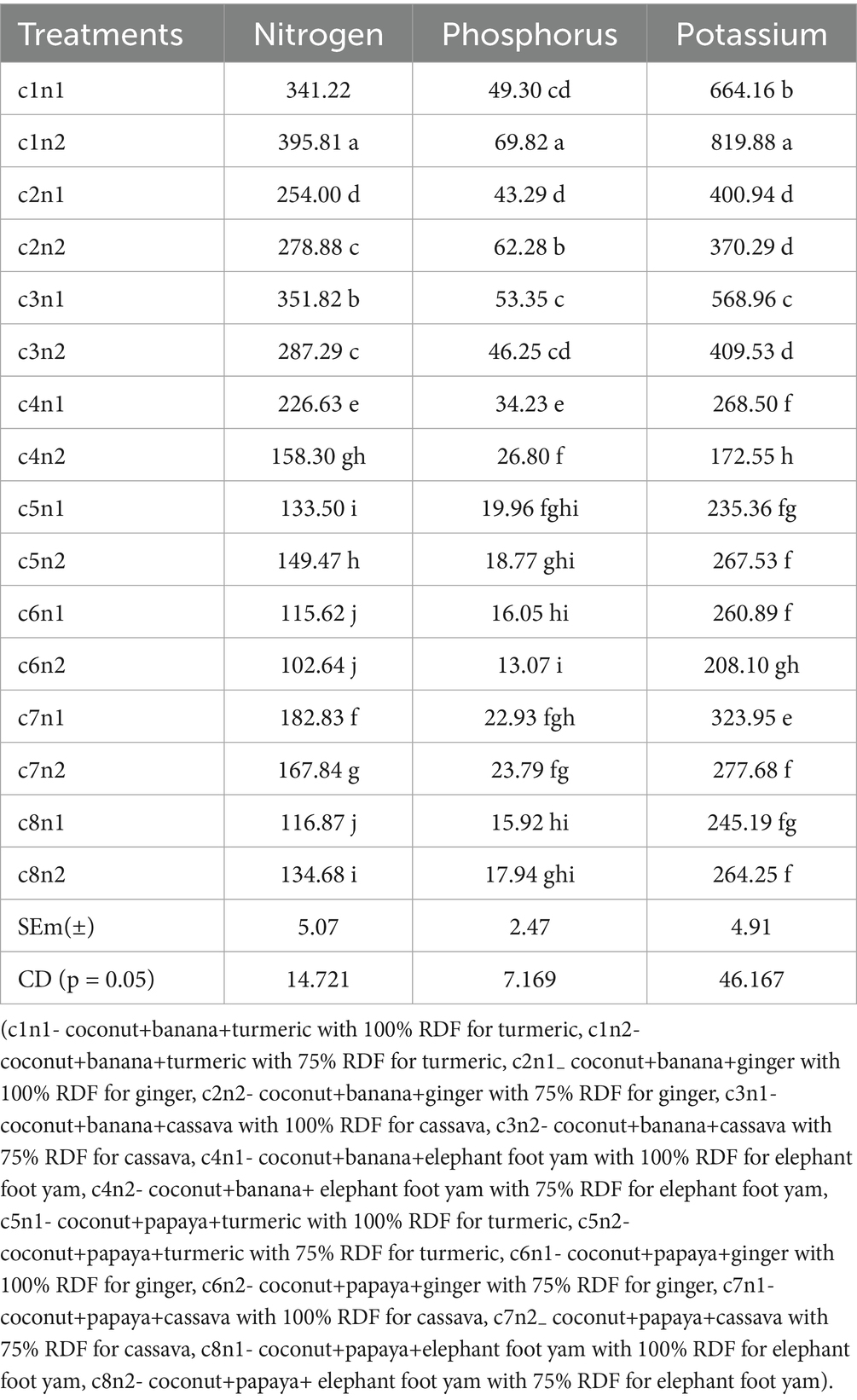
Table 7. Nitrogen, phosphorus and potassium uptake of crops (kg ha−1) as influenced by the interaction of crop combinations and floor crop nutrition.

Table 8. Nitrogen content of intercrops crops as influenced by the interaction of crop combinations and floor crop nutrition, (%).

Table 9. Phosphorus content of intercrops crops as influenced by the interaction of crop combinations and floor crop nutrition, (%).
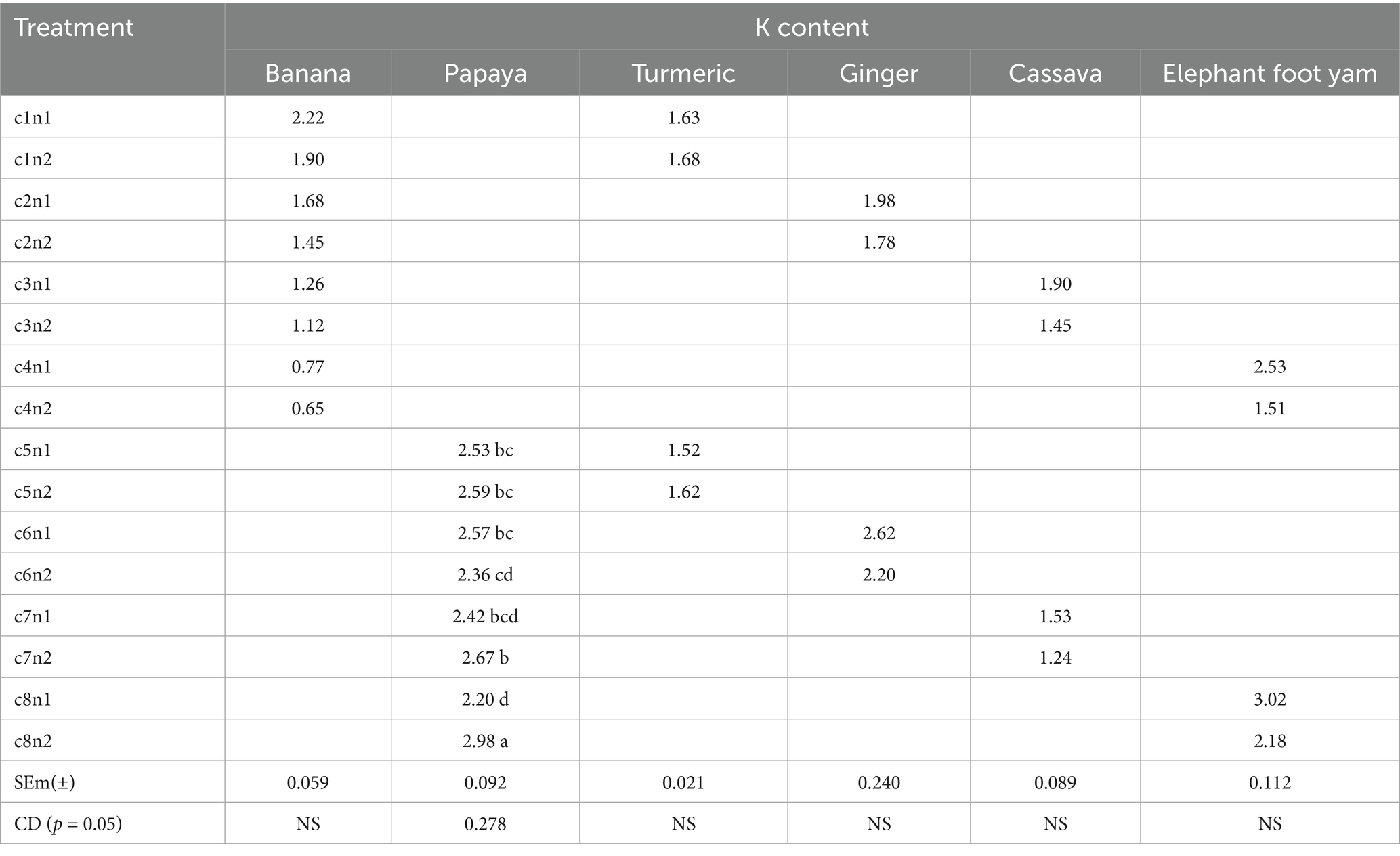
Table 10. Potassium content of intercrops crops as influenced by the interaction of crop combinations and floor crop nutrition, (%).
3.1.4 Economics of cultivation
Favorable crop combinations can maximize land profitability, thereby optimizing economic return. However, there were significant differences in the gross return among these treatment combinations (Table 11). The highest gross return was achieved by turmeric with 75% RDF in combination with coconut+banana+turmeric (c1n2; $23,852 ha−1 yr−1), the second highest was turmeric with 100% RDF under the same cropping system (c1n1; $21,456 ha−1 yr−1). The lowest gross return was for the coconut+papaya+cassava crop combination, with cassava (c7n1) getting 100% RDF ($12,344 ha−1 yr−1). The cost of cultivation was statistically similar between treatments. On a net return basis, the most beneficial one was coconut+banana+turmeric with 75% RDF for turmeric (c1n2), which recorded a net return of $13,528 ha−1 yr−1(Table 11). After that, coconut + banana + turmeric at 100% RDF for turmeric (c1n1), which gave a net return of $11,191 ha−1 yr−1. The lowest net return was found to be in coconut +papaya +elephant foot yam with 100% RDF elephant foot yam (c8n1), with a net return of $1,563 ha−1 yr−1. The BCR was also recorded the highest (2.31) in c1n1. The gross return, net return, and BCR of the economic assessment show that coconut + banana + turmeric with 75% RDF for turmeric (c1n2) is the best combination. As such c1n2 can lead to very substantial financial benefits associated with maximizing profitability. On the other hand, coconut + papaya + elephant foot yam with 100% RDF for elephant foot yam (c8n1) that offered advantages elsewhere, also showed the lowest economic return, implying low financial viability.
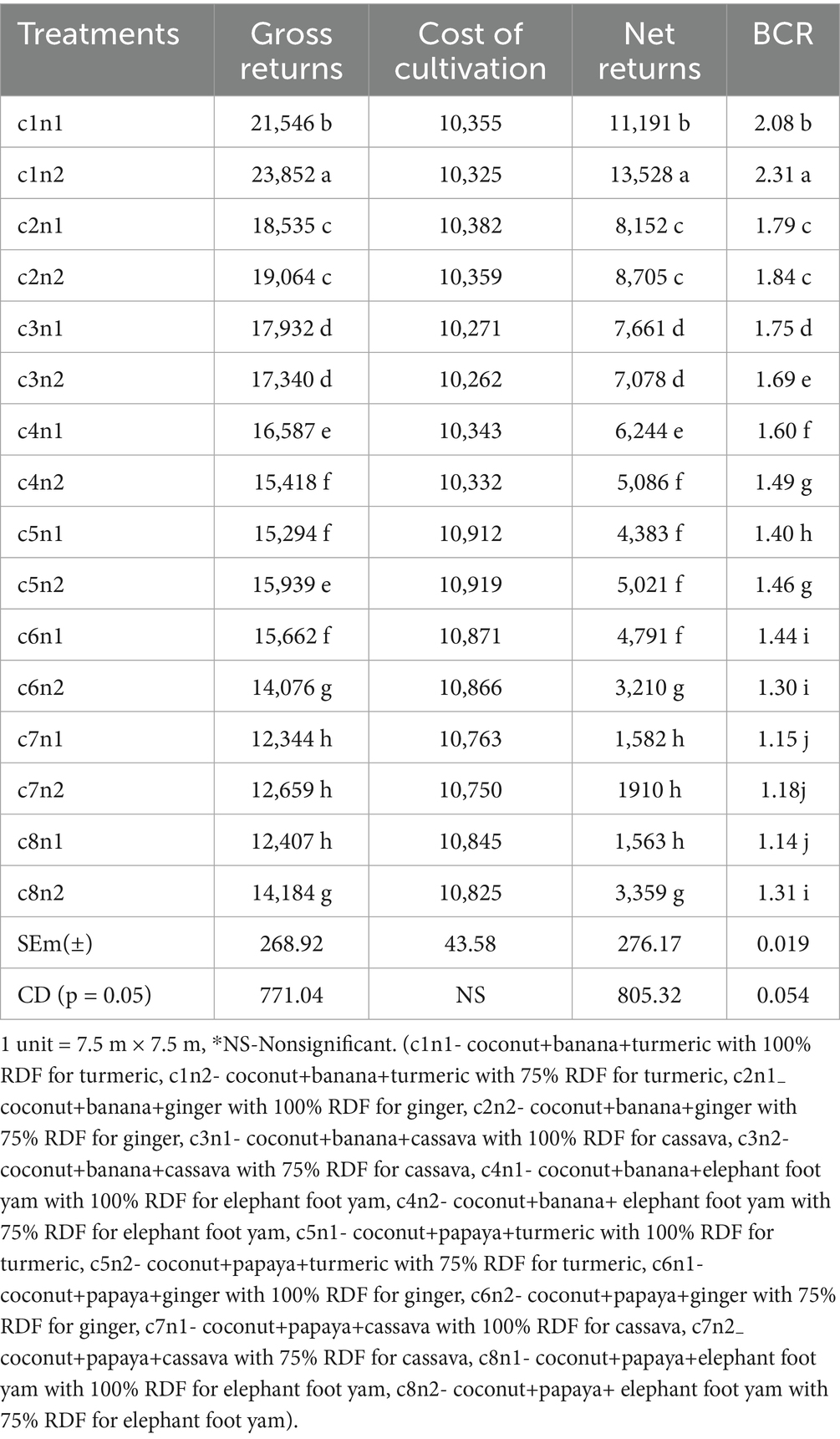
Table 11. Economics of the cultivation of coconut-based multistoried cropping systems as influenced by crop combinations and floor crop nutrient doses, $ ha−1 yr−1.
3.2 Soil quality indicators
3.2.1 Soil microbial indicators
Both the urease and dehydrogenase enzyme activities in the soil were significantly affected by the interaction of crop combination and floor crop nutrition (Table 12). The highest urease enzyme activity was recorded in coconut + banana + turmeric with 100% RDF of turmeric (c1n1) (546.21 μg urea hydrolyzed g−1 soil in 4 h−1) and coconut + banana + ginger with 100% RDF of ginger (c2n1) (490.61 μg urea hydrolyzed g−1 soil in 4 h−1). The treatment with the lowest activity, in this case, is the coconut + papaya + cassava with 75% RDF for cassava (c7n2) with an activity of 257.19 μg urea hydrolyzed g−1 soil for 4 h−1. Analogously, the coconut+ banana + turmeric with 100% RDF for turmeric (c1n1) had the highest dehydrogenase enzyme activity, i.e., 18.31 μg TFP g−1 soil d-1, which was on par with the coconut+ banana + turmeric with 75% RDF for turmeric (c1n2) (17.26 μg TFP g−1 soil d−1). The lowest dehydrogenase enzyme activity was observed in c7n2 (coconut + papaya + cassava with 75% RDF for cassava) (7.01 μg TFP g−1 soil d−1). However, notably, the urease and dehydrogenase enzyme activity were always high in the combinations of banana. Additionally, similar enzyme activities were observed with 75% RDF in specific combinations, indicating that high soil enzyme activities could be maintained using 75% RDF in combination with coconut and bananas in particular.
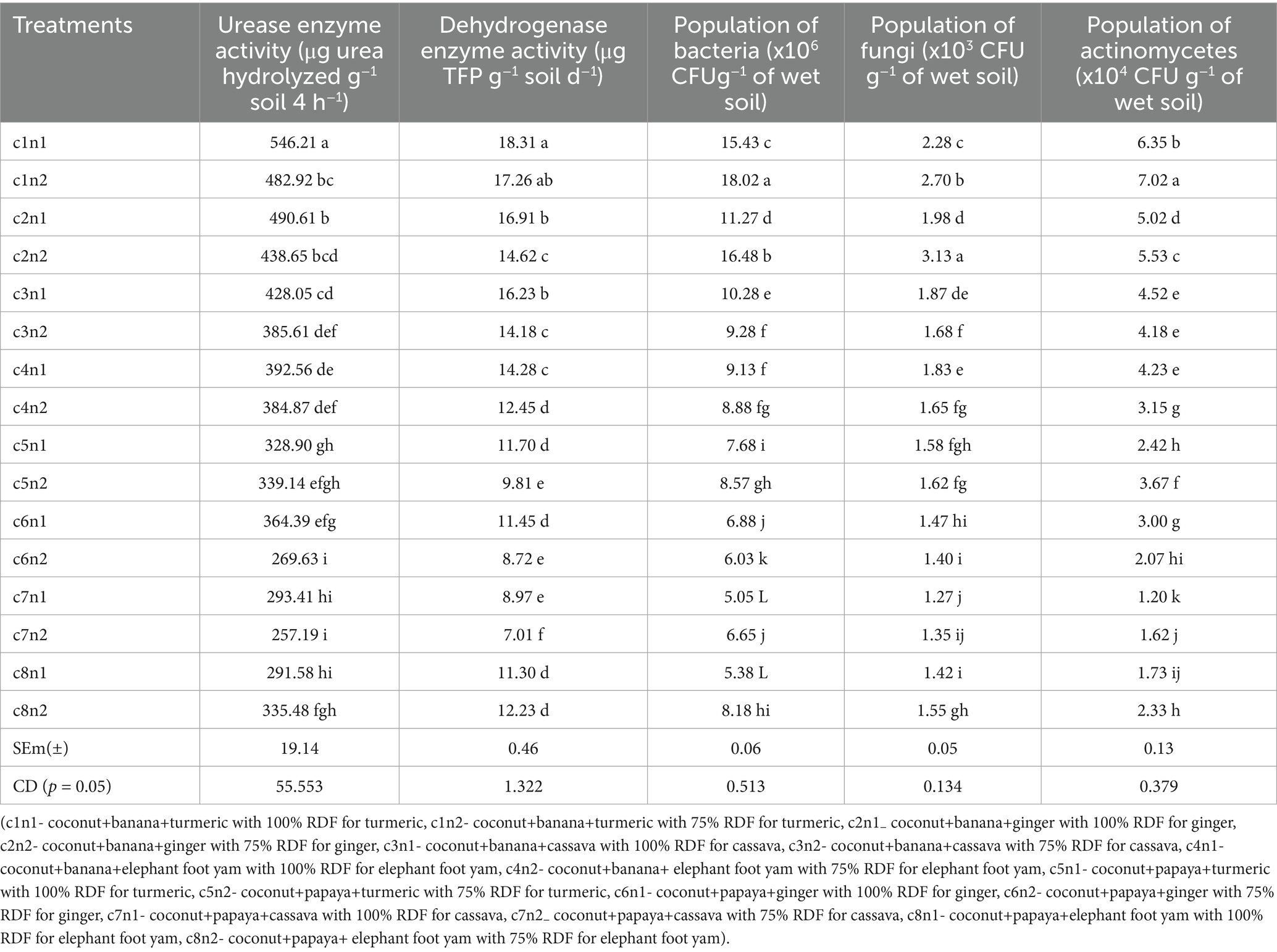
Table 12. Enzymatic activity and microbial population in coconut-based multistoried cropping systems as influenced by crop combinations and floor crop nutrient doses.
The impact of crop combinations and floor crop nutrition on the soil matrix microbiota is significant (Table 12). Bacteria populations varied among treatment combinations. Among the treatments, a combination of coconut + banana + turmeric with 75% RDF for turmeric (c1n2) resulted in the highest bacterial population density 18.02 × 106 CFU g−1 of wet soil. Coconut+ banana+ ginger with 75% RDF for ginger (c2n2) again showed a healthy bacterial community with 16.48 × 106 CFU g−1 of wet soil. On the other hand, when coconut+papaya+cassava were combined with 100% RDF for cassava (c7n1), a significant drop in bacterial population was observed (5.05 × 106 CFU g−1 of wet soil). Combining coconut+ banana+ ginger with 75% RDF for ginger (c2n2) resulted in a relatively high cumulative fungal population of 3.13 × 103 CFU g−1 wet soil. Intercropping turmeric with coconut and banana, both at 100 and 75% RDF for turmeric, also showed relatively high density for fungal populations. On the other hand, fungal colonization was suppressed in coconut+papaya+cassava with 100% RDF for cassava (c7n1) (1.27 × 103 CFU g−1 wet soil). It was found that the actinomycete proliferation is highest in coconut+banana+turmeric with 75% RDF for turmeric (c1n2) with a significantly higher population of 7.02 × 104 CFU g−1 wet soil. Conversely, cassava intercropped with coconut and papaya (c7n1) with 100% RDF had the lowest population of actinomycete (1.20 × 103 CFU g−1 wet soil).
3.2.2 Soil chemical parameters
The variations in soil pH, EC, SOC, and NPK availability were studied across crop combinations and nutrient management treatments (Table 13). Soil pH and EC were not significantly different among treatment combinations. This may be due to the same management practices over 60 years in this coconut plantation. This area was intentionally selected as it gives a stabilized and mature system in which the effects of improper or irregular management practices during the previous years can be minimized. The spacing, irrigation, and nutrient management practices remain the same except for some seasonal changes. Overall, the activity in the area remains the same. Notably, there was considerable variation in soil organic carbon (SOC) levels across the different treatments. Among these treatments, coconut + banana + turmeric with 75% RDF for turmeric had the highest SOC (0.67%), slightly followed by c1n1, c2n1 and c2n2 having SOC levels of 0.62, 0.57, and 0.55%, respectively. The availability of P was found to be higher in coconut+ banana+ turmeric with 100% RDF (61.04 kg ha−1), which was on par with coconut+ banana+ ginger with 100% RDF (c2n1) and coconut + banana+ cassava with 100% RDF (c3n1). The lowest P availability was observed in coconut+papaya+cassava treatment (c7n2) with 12.88 kg ha−1, where cassava was fertilized with 75% RDF for cassava. For potassium (K), soil available K was the lowest in treatment c7n1, whereas it was highest in treatment c2n1.
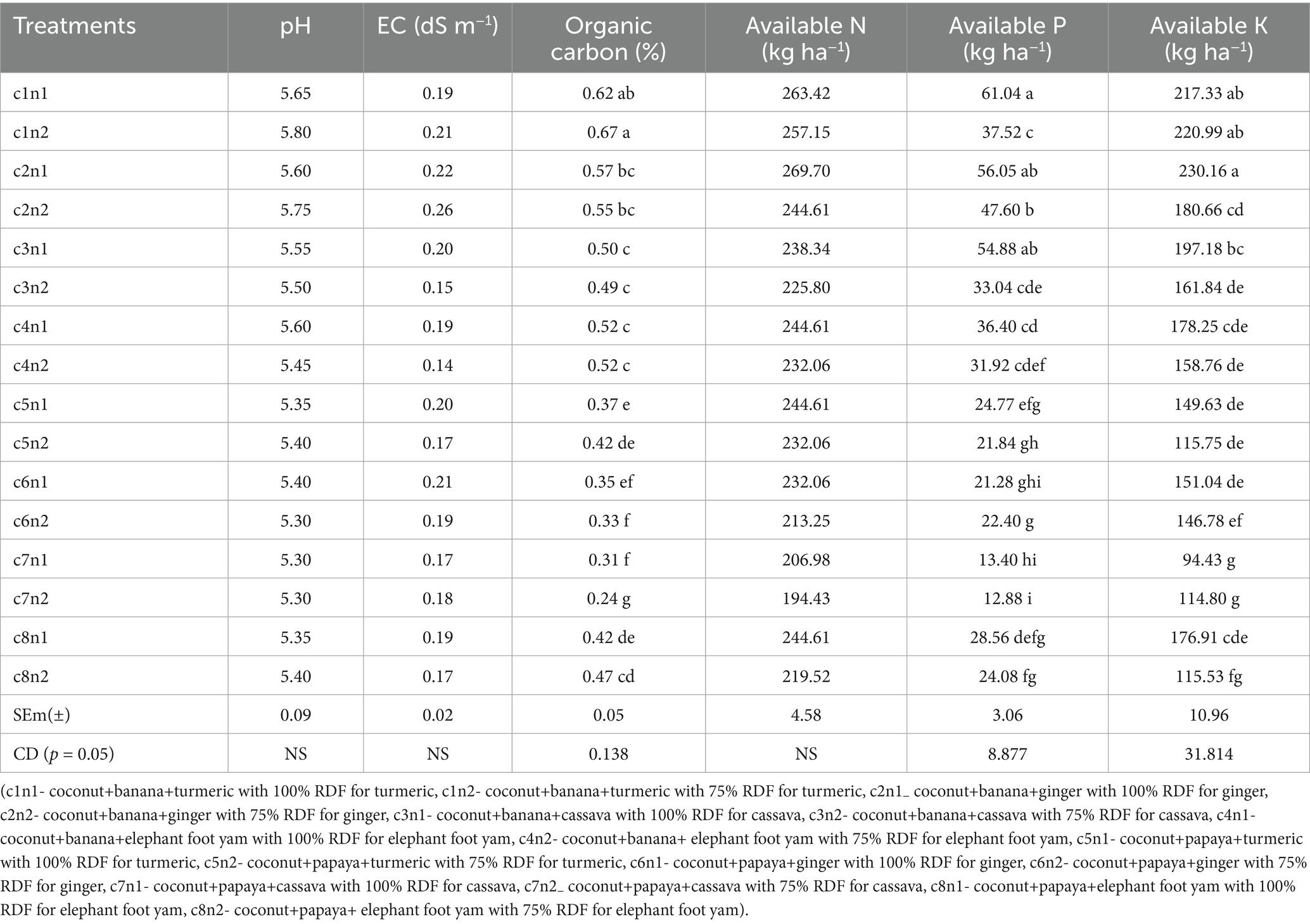
Table 13. Soil pH, EC, organic carbon content, and available NPK status in coconut-based multistoried cropping systems are influenced by crop combinations and floor crop nutrient dose, kg ha−1.
4 Discussion
4.1 Provisioning services
4.1.1 Above-ground effect
Among the treatment combinations, the highest bunch yield of banana intercropped with turmeric as a floor crop and fertilized with 75% RDF, was attributed to the beneficial interactions of the two crops. Dissanayake and Palihakkara (2024) found that, in a study conducted among oil palm plantations, intercropping banana with turmeric resulted in a significantly higher banana yield compared to monocropping. Similarly, Tripathi et al. (2021) reported that integrated nutrient management also improves crop yield and water use efficiency. These results suggest that the synergistic interaction between banana–turmeric intercropping and the application of 75% RDF contributed to a more favorable growing environment, thereby enhancing banana bunch yield. If intercropped papaya with coconut or elephant foot yam with 100 percent RDF, high papaya yields could also be obtained owing to the synergistic effect of intercropping in combination with optimal nutrient management. Intercropping systems, such as pineapple + papaya + mukhikachu, improve crop productivity and profitability (Khan et al., 2023). Elephant foot yam was a shade lover that grew slowly for the first few months, and soon the papaya grew to overtake without competition. Nevertheless, while papaya is intercropped with cassava, yield of papaya is reduced compared to other floor crops because of competitive use by papaya for resources during the early growth stages.
4.1.2 Below-ground effect
Turmeric is a shade-loving plant that can tolerate partial or filtered sunlight under adequate nourishment, especially during the hottest parts of the day (Sharangi et al., 2022). Banana plants are characterized by large, crowded leaves and a dense canopy, capturing more sunlight and creating more favorable microenvironment for the turmeric plant, thereby increasing turmeric yield when intercropped with banana, relative to papaya. The morphological parameters of turmeric in coconut gardens were significantly increased when shade was provided (Hossain et al., 2009). According to Alam et al. (2014), turmeric showed a significant increase in plant height, leaf length, shoot biomass, and fresh and dry weight of the rhizomes when exposed to 33–50% shade. Additionally, the consortium of microbial diversity in the banana-based cropping system supported the growth and development of the intercrops. Supply of an optimum dose of nutrients also increased nutrient uptake; ultimately, it produced more nitrogenous compounds in plant tissues and contributed to efficient plant metabolism (Mahendran et al., 2022). Stem and leaf assimilate translocation to sinks (rhizomes) is enhanced by greater vegetative growth, supported by greater N uptake.
Ginger also belongs to the same Zingiberaceae family as of turmeric. Ginger recorded higher yields when it was given a full dose of fertilizer in the papaya and coconut based cropping system (c6n1). According to Ghasemzadeh et al. (2010), higher yield of ginger was obtained at the 25% shade level as it is a shade-loving plant. In the present study, the ginger yield was higher in papaya than in banana, which may be because of higher shade under banana. Banana is having denser canopy architecture than papaya, therefore banana provide more shade to under stressed crops (Cattan et al., 2007). The same was also reported in some studies that shade above 60 per cent can reduce the yield of ginger by the reduced incidence of photosynthetic light (Aly et al., 2019; Babu et al., 2019). Moreover, yields of ginger intercropped in coconut gardens were considerably enhanced with relatively high applications of NPK, which underlines the significance of adequate nutrition for the purposeful farming (Ajithkumar and Jayachandran, 2001). Similarly, ginger is an excellent intercrop with both cereal and vegetable crops. The highest ginger equivalent yield was recorded in the intercropping system of ginger + maize + French bean + pumpkin (Rymbai et al., 2021).
Cassava is an excellent source of biomass due to its vigorous growth and efficient ability to capture soil moisture and nutrients, even under drought conditions (Cock, 2019). However, banana and coconut gave better yield to cassava (100% RDF). Competition between cassava and papaya, two component crops may have also contributed to the decrease in yield of the two crops when they were intercropped. While banana plants can root out nutrients from only a small area since they have a shallow root system (Vandana, 2004). According to Li et al. (2017) the spread of lateral roots is confined to 5-15 cm from the base of the corm of banana. This may have created a suitable rhizosphere space for the growth of intercrops with no detrimental effects on the growth or productivity of the banana. This is further supported by Ravi et al. (2021b) who suggested that cassava could be successfully intercropped under coconut, banana and rubber plantations. Suja et al. (2018) also reported that cassava (Vellayani Hraswa) intercropped with coconut produced higher yields at RDFs (FYM @ 12.5 t ha−1 and NPK @ 100:50:100 kg ha−1). Earlier work has also demonstrated that specific cropping systems and integrated nutrient management practices, combined with soil test based nutrient applications, can significantly improve the yield of crops like cassava, coconut and banana.
Complementary resource utilization and growth dynamics between crops were responsible for the better performance (growth) of the elephant foot yam growing in a coconut + papaya intercropping system with 100% RDF (c8n1). The intercropping of papaya and elephant foot yam under coconut plantations benefits from the tall, widely spaced canopy structure of the coconut trees, which allows ample light to penetrate to the lower strata, creating a favorable microenvironment for growth. Elephant foot yam needs a light environment to establish and grow, and the relatively fast-growing papaya crop can efficiently utilize the available light and nutrients in the early stages of crop establishment. Supporting this observation, Sinhababu et al. (2013) reported that elephant foot yam yield increased by up to 17% when intercropped with papaya under full recommended dose of fertilizer (RDF) application. The tuber yield of elephant foot yam increased up to 80% in the intercropping system with banana and papaya than sole cropping system (Nedunchezhiyan et al., 2022). Nayar et al. (2000) stated that banana plants should get the full RDF if dioscorea is intercropped with banana. In a study by Chandra (2014), elephant foot yam intercropped in guava orchards yielded 19.06% more than those grown in open field conditions, indicating the beneficial effects of intercropping amorphophallus in guava orchards. In addition, Singh et al. (2016) reported that the maximum fresh and marketable corm weight per plant of elephant foot yam was obtained when intercropped with amla, with 50% of the N supplied through urea and 25% through vermicompost.
This study finds that crop combination × nutrient management strategy interaction effects are very important in determining both coconut equivalent yield (NEY) and system productivity. Higher yields were recorded by combining coconut, banana, and turmeric, with 75% of the RDF for turmeric (c1n2). The highest NEY (475 nuts unit−1 yr−1) and system productivity, 736 nuts unit−1 yr−1 was achieved with this treatment. This marked difference highlights the comparative advantage of integrating banana with coconut in intercropping systems. The net equivalent yield (NEY) in the coconut + banana + turmeric system was nearly twice that of the coconut + papaya + turmeric system (c5n2). This is also confirmed by Shinde et al. (2021a) that the yield of coconut and component crops was increased due to the synergistic effect and optimum nutrient status of the soil. Consequently, these results highlighted that through strategic crop selection and nutrient management, agricultural productivity could increase. The marked difference highlights the clear comparative advantage of intercropping banana with coconut. Bananas, with their rapid growth and substantial biomass, likely enhanced the microclimate and soil conditions, benefiting both coconut and turmeric plants (Devi et al., 2011). In addition, turmeric role in coconut+banana+turmeric with 75% RDF for turmeric cannot be ruled out. Turmeric beds are mulched to suppress weed cover and increase water retention, providing a good microclimate for the growth of banana and turmeric. Ginger and turmeric, rhizomatous crops, were also among the best intercrops for high-density multi-species cropping systems (HDMSCS) with coconut because of their short duration and do not interfere with the performance of the main crop (Nath, 2002). Furthermore, the c1n2 system achieved high productivity with a reduced application of NPK at 75% of the RDF, potentially minimizing nutrient leaching and associated environmental impacts. This suggests improved nutrient use efficiency within the cropping system. Coconut and other intercrops produced higher yields with 2/3rd of the recommended dose of NPK than full dose (Reddy et al., 2002).
The combination of coconut + banana + turmeric with 75% RDF (c1n2) was most efficient in nutrient uptake (N, P, and K). Synergistic interaction between the three crops and a 25% reduction in fertilizer input to the floor crop modified the nutrient absorption and utilization of the system effectively. Coconut is the main crop with a reliable supply of organic matter and nutrients. On the contrary, banana and turmeric proved probably beneficial for efficient utilization of resources by their distinctive rooting patterns and nutrient requirements, respectively, when considered as intercrops. When applying 75% of RDF to the floor crop, a good environment was promoted for efficient utilization of available nutrients as well as biomass conversion, and supported relatively high yield. Since the soil was initially high in K and banana is a nutrient-depleting crop, this may have encouraged greater use of N and P. Additionally, floor crop nutrition can lead to specific physiological crop responses, for example, to changes in hormone levels or stress signaling pathways (Kuttimani et al., 2013). These responses may have led to more efficient resource allocation and biomass partitioning toward yield components, resulting in higher productivity. Besides the moderately available N and highly available K in the soil, green leaf mulching, FYM addition, and crop residue from the banana crop likely contributed to a balanced nutritional status, promoting effective nutrient uptake by turmeric (Nihad et al., 2023). Enhanced microbial activity in the rhizosphere soil contributed to increased nutrient availability and greater uptake of N, P, and K. The diverse cropping system itself enhanced microbial activity in the rhizosphere, leading to improved nutrient availability and uptake (Nelliat et al., 1974; Harisha et al., 2023). The synergy between the Herb model and all other components resulted in a balanced and highly productive system, supporting the importance of proper nutrient management and crop selection. This high variability in nutrient uptake between the three highest and three lowest performing treatments emphasizes the need to select correct crop combinations and nutrient management strategies to maximize nutrient use efficiency. The combination of coconut + banana + turmeric with 75% RDF as turmeric (c1n2) has the potential to increase nutrient uptake and presents a possible pathway for increasing crop productivity as well as soil fertility. The c1n2 system exhibited higher uptake of N, P, and K, indicating that its proper implementation could improve nutrient absorption, leading to enhanced growth and increased yield.
Coconut, banana, and turmeric, when integrated into a cropping system, have proven to produce higher yields, and each crop seems to contribute positively to the overall productivity of the system. Applying 75% RDF of turmeric as a floor crop for maintaining balanced nutrient utilization can increase the yield and can be regarded as a judicious and cost-effective application of fertilizers (that too sufficient) to get satisfactory results. Turmeric and ginger are sold at the same market price but have different yields. Tuber crops had the lowest net income because their market value was lower than of rhizomatous species. But cassava and elephant foot yam raised the food value, the caloric value, or the energy of the cropping system. Devi et al. (2013), reported that banana and tuber crops had the lowest net income in cropping systems. A combination of coconut and turmeric showed the highest net return, followed by coconut, banana, and ginger (Nagwekar et al., 2010). Dissanayake et al. (2023) reported that profitability and ecosystem services in coconut-based agroforestry systems have been extensively studied, highlighting their potential for sustainable agricultural development.
4.2 Supporting services
In this study, the effects of crop combinations and floor crop nutrition on soil enzyme activities, microbial populations, and chemical indicators are investigated to better understand soil health and fertility. In the cropping systems, coconut+banana+turmeric with 100% RDF for turmeric (c1n1) recorded the highest urease and dehydrogenase enzyme activities. Higher enzymatic activity at c1n2 and c1n1 might have been due to the integrated use of chemical fertilizers (urea, Rajphos, MOP) and organic sources (FYM and crop residue addition), which might have improved the overall growth of the crop. This resulted in greater biomass production in c1n2 and c1n1, leading to increased return of organic residues to the soil. These residues serve as a source of carbon and energy for microbial growth and multiplication, which in turn enhances dehydrogenase activity in c1n2. Ghosh and Bandopadhyay (2011) further supported these findings by reporting that the activity of soil enzymes, such as urease and dehydrogenase, was higher in mixed farming systems involving coconut compared to coconut monocropping. Banana root exudates also contribute to the regulation of soil enzymatic activity. Organic acids such as oxalic, malic, and fumaric acids, present in these exudates, play a key role in promoting the growth and activity of plant growth-promoting rhizobacteria (PGPR) (Li et al., 2018). Furthermore, the organic acids beneficially stimulate microbial activity and promote soil health, as reported by Yuan et al. (2018).
Although crop combinations and nutrient doses differed, the soil pH and EC were not significantly changed during the study period (Table 13). All of this can be attributed to the diversity of the cropping systems (combinations of coconut, banana, turmeric, etc), and the balanced nutrient management practices in the study likely mitigating any shifts. The SOC was significantly influenced by the interactions, and coconut + banana + turmeric treated with 75% RDF was the most performing treatment. This finding is consistent with larger-scale research on soil organic carbon sequestration. Studies have shown that certain crop combinations can maintain high organic carbon content in the soil; for example, the coconut + pineapple intercropping system (Sudha and George, 2011) and organic nutrient management practices have led to increasing soil organic carbon levels (Bondre et al., 2019). As shown by Shinde et al. (2021b), growing intercrops in coconut gardens contributes to the generation of recyclable biomass which, in turn, increases soil organic carbon levels. Mishra et al. (2022) also reported an increase in soil organic carbon (SOC) in coconut-based cropping systems compared to monocropped gardens. They further suggested that SOC decreases with increased use of chemical fertilizers. Kumar et al. (2016) reported comparable effects in coconut-based cropping systems practicing integrated nutrient management (INM). The present study indicates that increased soil organic carbon (SOC) enhances the soil microbial population.
Coconut, banana, and turmeric intercropping systems were found to have the highest soil available P (100% RDF for turmeric c1n1). The system also increased dehydrogenase activity, which is a crucial measure of overall microbial activity in the soil. The combined effect of a growing microbial population and enhanced dehydrogenase activity increases the decomposition and mineralization of organic matter. Organic matter is very important as it acts as a source of P in soil; its breakdown, which releases P bound in organic compounds, makes it available to the soil (Ghosh and Bandopadhyay, 2011). Farsanashamin (2015) found that in coconut-based intercropping systems with noni, banana, and long pepper, the highest soil P occurred when two-thirds of the recommended NPK dose was applied to coconut, coupled with 100% RDF for the intercrops. The treatment combination coconut+banana+ginger with 100% RDF for ginger (c2n1) recorded significantly higher soil available K, and this was statistically comparable to c1n2 and c1n1. The SOC content was significantly higher for c1n2, which was also statistically on par with c1n1 and c2n1. Potassium is a nutrient that is found in organic matter and helps in adsorbing or holding K+ ions and preventing leaching from soil (Kukal and Benbi, 2009). This mechanism likely contributed to the increased soil available K observed in the treatment combinations c2n1, c1n2, and c1n1. It is likely that this mechanism also contributed to the higher soil available K resulting from the c2n1, c1n2, and c1n1. An increase in available soil NPK content was also reported by Shinde et al. (2021b) in coconut-based multitier cropping systems.
The study incorporates a diverse mixture of crops differing in size, shape, and canopy architecture. Notably, the contrasting canopy structures of banana and papaya significantly influenced the growth and development of floor crops. Banana, with its dense canopy and broad leaves, limits light penetration and creates more shade compared to papaya. This shaded microclimate was particularly favorable for turmeric, a shade-loving crop, leading to higher system productivity and profitability in the c1n1 system. Furthermore, the selected crops exhibit varying nutrient requirements and uptake patterns, minimizing interspecific competition for nutrients. Banana, and papaya possess deep root systems that extract nutrients from the deeper soil layers. Cassava has a moderately deep root system, accessing nutrients from the middle layer. In contrast, turmeric, ginger, and elephant foot yam have shallow root systems, primarily absorbing nutrients from the topsoil. Thus, the system effectively integrates crops with three distinct rooting depths and nutrient acquisition zones. This spatial differentiation reduces competition and maximizes nutrient use efficiency, aligning with the principles of the Nutrient Niche Theory. The variation in canopy spread, root architecture, and nutrient requirements among the crops fosters synergistic interactions—particularly evident in the coconut + banana + turmeric system with 75% RDF applied to turmeric—resulting in enhanced overall productivity and sustainability.
5 Conclusion
The study highlights that incorporating banana and turmeric as intercrops in coconut-based systems, along with a full recommended dose of fertilizer (RDF) for coconut and banana and 75% RDF for turmeric produced the greatest above- and below-ground effects, leading to the highest yields across multiple crops, the maximum coconut equivalent yield per hectare, the highest overall system productivity, gross and net returns, making it the most profitable and sustainable combination tested. Nutrient uptake was significantly greater under this treatment, reflecting improved nutrient use efficiency. In addition, soil health indicators—including urease and dehydrogenase enzyme activities and microbial population levels—were markedly higher in treatments involving banana, indicating enhanced biological activity in the rhizosphere. Adoption of this model can be recommended especially for aged coconut palms in Kerala. Since this study was conducted in a short-term period, long-term evaluation can also be done to evaluate the soil impact and climatic resilience of the system.
Data availability statement
The original contributions presented in the study are included in the article/supplementary material, further inquiries can be directed to the corresponding authors.
Author contributions
VN: Writing – review & editing, Conceptualization, Methodology, Writing – original draft, Formal analysis, Investigation, Data curation. SR: Writing – review & editing, Supervision, Writing – original draft, Conceptualization, Methodology, Data curation, Formal analysis. DJ: Software, Writing – original draft, Visualization, Resources, Supervision, Validation, Writing – review & editing, Conceptualization. PP: Project administration, Validation, Supervision, Writing – original draft, Software, Writing – review & editing, Investigation. NR: Writing – original draft, Software, Visualization, Writing – review & editing, Validation, Supervision. VP: Writing – original draft, Writing – review & editing, Formal analysis, Data curation, Conceptualization. AN: Writing – review & editing, Writing – original draft, Supervision, Visualization, Validation.
Funding
The author(s) declare that financial support was received for the research and/or publication of this article.
Acknowledgments
The authors acknowledge Kerala Agricultural University, Thrissur, and Kerala for providing funds for the research.
Conflict of interest
The authors declare that the research was conducted in the absence of any commercial or financial relationships that could be construed as a potential conflict of interest.
Generative AI statement
The authors declare that no Gen AI was used in the creation of this manuscript.
Publisher’s note
All claims expressed in this article are solely those of the authors and do not necessarily represent those of their affiliated organizations, or those of the publisher, the editors and the reviewers. Any product that may be evaluated in this article, or claim that may be made by its manufacturer, is not guaranteed or endorsed by the publisher.
References
Ajithkumar, K., and Jayachandran, B. K. (2001). Effect of major nutrients on yield of ginger (Zingiber officinale rose.) intercropped in coconut garden. J. Spices Aromat. Crops. 10, 17–23.
Alam, B., Chaturvedi, M., Singh, R., Newaj, R., and Dhyani, S. K. (2014). Physiological determinants for adaptive potential of turmeric (Curcuma longa) for its growth and yield under different regimes of shade in semiarid region of Central India. Indian J. Agrofor. 16, 25–29.
Aly, M. M., El Sawy, A., and El Gendy, R. A. (2019). Comparative study of different shading types on growth and yield of ginger plants. Mid. East J. 8, 1264–1270. doi: 10.36632/mejar/2019.8.4.28
Babu, M. S., Kumar, B. P., Swami, D. V., Krishna, K. U., and Emmanuel, N. (2019). Impact of shade net condition on growth, rhizome and yield characters of ginger. J. Pharmacogn. Phytochem. 8, 3481–3485.
Bondre, S. V., Nagre, P. K., Kale, V. S., Gupta, N. S., and Wagh, A. P. (2019). Chemical properties and microbial population of soil as influenced by different organic nutrient sources in turmeric. J. Pharmacogn. Phytochem. 8, 2150–2153.
Brooker, R. W., Bennett, A. E., Cong, W. F., Daniell, T. J., George, T. S., Hallett, P. D., et al. (2015). Improving intercropping: a synthesis of research in agronomy, plant physiology and ecology. New Phytol. 206, 107–117. doi: 10.1111/nph.13132
Casida, L. E., Klein, D. A., and Santoo, T. (1964). Soil dehydrogenase activity. Soil Sci. 98, 371–376.
Cattan, P., Bussiere, F., and Nouvellon, A. (2007). Evidence of large rainfall partitioning patterns by banana and impact on surface runoff generation. Hydrol. Process. 21, 2196–2205. doi: 10.1002/hyp.6588
CDB. (2023). CDB home page. Available online at: http://www.coconutboard.gov.in.
Chandra, K. K. (2014). Evaluation of growth and economic parameters of Curcuma longa and Amorphophallus paeoniifolius intercrops in medium aged Pisidium guajava orchard. Caribbean J. Sci. Technol. 2, 392–398.
Cock, J. H. (2019). Cassava: New potential for a neglected crop. Boca Raton, FL: Chemical Rubber Company.
CPCRI. (2014). Annual report 2013–14. Central plantation crops research institute, Kasaragod, India.
Devi, L. G., Gladis, R., and Joseph, B. (2011). Performance studies of various crops in coconut based cropping system compared to sole cropping. J. Prog. Agric. 2, 47–50.
Devi, L. G., Gladis, R., and Joseph, B. (2013). Multiple cropping systems involving cassava and elephant foot yam in coconut gardens. J. Root Crops 39, 242–246.
Dissanayake, S. M., and Palihakkara, I. R. (2024). Effects of intercropping of immature oil palm (Elaeis guineensis) with banana, ginger, and turmeric in the Galle District, Sri Lanka. Environ. Qual. Manag. 33, 31–36. doi: 10.1002/tqem.21980
Dissanayake, D., Udumann, S. S., Nuwarapaksha, T. D., and Atapattu, A. J. (2023). Agroforestry—a key tool in the climate-smart agriculture context: a review on coconut cultivation in Sri Lanka. Front. Agron. 5:1162750. doi: 10.3389/fagro.2023.1162750
Farsanashamin, P. (2015). Nutrient management for coconut based multistoryed cropping system in a typical coastal sandy zone. M.Sc. (ag.) thesis, Kerala agricultural university, Thrissur.
Gadhe, S., and Mathur, A. (2018). Overview of homestead farming-coconut in Kerala. Int. J. Bioresour. Stress Manag. 9, 249–252. doi: 10.23910/IJBSM/2018.9.2.3C0569
Ghasemzadeh, A., Jaafar, H. Z. E., and Ridzwan, A. H. (2010). Effect of different light intensities on total phenolics and flavonoids synthesis and antioxidant activities in young ginger varieties (Zingiber officinale). Int. J. Mol. Sci. 11, 3885–3897. doi: 10.3390/ijms11103885
Ghosh, D. K. (2009). Performance of black pepper (Piper nigrum L) as intercrop with coconut in the alluvial plains of West Bengal. Indian Coconut J., 4–7.
Ghosh, D. K., and Bandopadhyay, A. (2011). Productivity and profitability of coconut based cropping systems with fruits and black pepper in West Bengal. J. Crop Weed 7, 134–137.
Harisha, C. B., Meena, K. K., Rane, J., Halli, H. M., Manjanna, B. K., Patil, B. S., et al. (2023). Bacterial derived biopolymer to alleviate nutrient stress and yield enhancement in turmeric (Curcuma longa L.) by mediating physiology and rhizosphere microbes on poor soils of semiarid tropics. Arch. Agron. Soil Sci. 69, 2645–2662. doi: 10.1080/03650340.2023.2170362
Hossain, M. A., Akamine, H., Ishimine, Y., Teruya, R., Aniya, Y., and Yamawaki, K. (2009). Effects of relative light intensity on the growth, yield and curcumin content of turmeric (Curcuma longa L.) in Okinawa, Japan. Plant Prod. Sci. 12, 29–36. doi: 10.1626/pps.12.29
Johnson, L. F., and Curl, E. A. (1972). Methods for research in the ecology of soil- borne plant pathogen. Minneapolis: Burgers publication Co.
KAU (2016). Package of practices recommendation: Crops. 16th Edn. Kerala, Thrissur: Kerala Agricultural University.
Khan, M. A. H., Rahman, M. M., and Sultana, N. (2023). Intercropping of mukhikachu and papaya with pineapple. SAARC J. Agric. 21, 25–40. doi: 10.3329/sja.v21i1.65577
Kukal, S. S., and Benbi, D. K. (2009). Soil organic carbon sequestration in relation to organic and inorganic fertilization in rice–wheat and maize–wheat systems. Soil Tillage Res. 102, 87–92. doi: 10.1016/j.still.2008.07.017
Kumar, N. K. S., Maheswarappa, H. P., and Basavaraju, T. B. (2016). Effect of integrated nutrient management practices on growth and yield of vegetable crops grown as intercrops in coconut garden. Indian J. Agric. Sci. 86, 1361–1365.
Kumar, N. K. S., Maheswarappa, H. P., and Basavaraju, T. B. (2017). Productivity and economic benefits of coconut based vegetable cropping systems under central dry zone of Karnataka. J. Plant. Crops 45, 49–56. doi: 10.19071/jpc.2017.v45.i1.3237
Kuttimani, R., Velayudham, K., Somasundaram, E., and Jothi, N. J. (2013). Effect of integrated nutrient management on corm and root growth and physiological parameters of banana. Int. J. Adv. Res. 1, 46–55.
Li, C., Yang, J., Li, W., Sun, J., and Peng, M. (2017). Direct root penetration and rhizome vascular colonization by Fusarium oxysporum f. sp. cubense are the key steps in the successful infection of Brazil Cavendish. Plant Dis. 101, 2073–2078. doi: 10.1094/PDIS-04-17-0467-RE
Li, H. Y., Zhou, X. G., and Wu, F. Z. (2018). Effects of root exudates from potato onion on Verticillium dahliae. J. Allelopath. 43, 217–222. doi: 10.26651/allelo.j./2018-43-2-1142
Mahendran, P. P., Suganya, S., Kannan, P., and Yuvaraj, M. (2022). Growth, nutrient uptake, yield and quality parameters of nendran banana (Musa spp.): as influenced by the application of boron in typic rhodustalf of Theni district, Tamil Nadu, India. Commun. Soil Sci. Plant Anal. 53, 559–575. doi: 10.1080/00103624.2021.2017958
Maheswarappa, H. P., Hegde, M. R., Dhanapal, R., and Biddappa, C. C. (2007). Mixed farming in coconut garden: its impact on soil, physical and chemical properties, coconut nutrition and yield. J. Plant. Crops 26, 139–143.
Maheswarappa, H. P., Subramanian, P., and Dhanapal, R. (2000). Root distribution pattern of coconut (Cocos nucifera L.) in littoral sandy soil. J. Plant. Crops 28, 164–166.
Meerabai, M., Jayachandran, B. K., Asha, K. R., and Geetha, V. (2000). Boosting spice production under coconut gardens of Kerala: maximizing yield of turmeric with balanced fertilization. Better Crops Int. 14, 10–12.
Mensah, R., Issaka, N., and Ennin, A. S. (2011). Evaluation of growth of young coconut and nut yield of old coconut and their nutrient status under coconut-cassava intercropping systems. J. Sci. Technol. 31, 1–9.
Mishra, G., Karna, S. S. A., Pattanayak, S., and Maheswarappa, H. (2022). Effect of coconut based integrated cropping system on soil organic carbon and microbial populations in coastal Odisha condition. Ecol. Environ. Conserv. 28, 133–137. doi: 10.53550/EEC.2022.v28i01s.019
Nagwekar, D. D., Desai, V. S., Sawant, V. S., Haldankar, P. M., Arulraj, S., and Jadhav, B. B. (2010). “Intercropping with fruits and annual spices in coconut under Konkan condition of Maharashtra” in Improving productivity and profitability in coconut farming. eds. G. V. Thomas, V. Krishnakumar, and B. A. Jerard (Kasaragod: Central Plantation Crops Research Institute).
Nair, K. M., Haris, A., Mathew, J., Srinivasan, V., Dinesh, R., and Hamza, H. (2018). Coconut-growing soils of Kerala: 2. Assessment of fertility and soil-related constraints to coconut production. J. Plant. Crops. 46, 84–91. doi: 10.25081/jpc.2018.v46.i2.3719
Narmadha, N., Karunakaran, K. R., Anjugam, M., Palanisamy, N. V., and Vasanthi, R. (2022). An economic analysis on Indian scenario of coconut production: trends and prospects. Indian J. Agron. 67, 263–269. doi: 10.46852/0424-2513.3.2022.16
Nath, J. C. (2002). Prospects of coconut based high density multistoryed cropping in Assam. Indian Coconut J. 1, 10–11.
Nath, J. C., and Deka, K. K. (2010). “Second generation coconut based high density multi species cropping system in Assam” in Improving productivity and profitability in coconut farming. eds. G. V. Thomas, V. Krishnakumar, and B. A. Jerard (Kasaragod: Central Plantation Crops Research Institute).
Nath, J. C., Deka, K. K., Maheswarappa, H. P., and Sumitha, S. (2019). System productivity enhancement in coconut (Cocos nucifera) garden by intercropping with flower crops in Assam. Indian J. Agric. Sci. 89, 1842–1845.
Nayar, T. V. R., Suja, G., and Byju, G. (2000). Effect of plant density and levels of manuring on productivity of banana- dioscorea intercropping system. In: Proceedings of international symposium on tropical root and tuber crops, 19–22 January 2000, central tuber crop research institute, Thiruvananthapuram
Nedunchezhiyan, M., Suja, G., and Ravi, V. (2022). Tropical root-and tuber crops-based cropping systems—a review. Curr. Hortic. 10, 14–22. doi: 10.5958/2455-7560.2022.00003.6
Nelliat, E. V., Bavappa, K. V. A., and Nair, P. K. R. (1974). Multistoryed cropping a new dimension in multiple cropping for coconut plantation. World Crops 26, 262–266.
Nihad, K., Haris, A. A., Subramanian, P., Mathew, J., Indhuja, S., Neenu, S., et al. (2023). Efficient nutrient recycling strategy through integrated nutrient management in hybrid napier within a coconut (Cocos nucifera) based system. Indian J. Agric. Sci. 93, 647–652. doi: 10.56093/ijas.v93i6.136165
Padma, E., Ramanandam, G., Rao, A. D., Kalpana, M., and Maheswarappa, H. P. (2018). Performance of medicinal and aromatic crops as intercrops in coconut garden under east coast of Andhra Pradesh. Int. J. Pure Appl. Biosci. 6, 421–426. doi: 10.18782/2320-7051.6031
Panse, V. G., and Sukhatme, P. V. (1985). Statistical method for agricultural workers. 4th Edn. New Delhi: Indian Council of Agricultural Research.
Ravi, V., Suja, G., and Ravindran, C. S. (2011a). Method for leaf area determination in Chinese potato (Plectranthus rotundifolius). J. Root Crops 37, 37–40.
Ravi, V., Suja, G., Saravanan, R., and More, S. J. (2021b). “Advances in cassava-based multiple-cropping systems” in Horticultural Reviews. ed. I. Warrington, vol. 48 (Hoboken, NJ: Wiley), 153–232.
Reddy, D. V. S., Subramanian, P., and Gopalasundaram, P. (2002). “Coconut based multispecies cropping system under different levels of fertilizers in red sandy loam soils” in Plantation crops Research and Development in the new millennium (PLACROSYM XIV). eds. P. Rethinam, H. H. Khan, V. M. Reddy, P. K. Mandal, and K. Suresh (Kochi, India: Coconut Development Board).
Rymbai, H., Das, A., Mohapatra, K. P., Talang, H. D., Nongbri, B., and Law, I. (2021). Ginger (Zingiber officinale) based intercropping systems for enhancing productivity and income–a farmers’ participatory approach. Indian J. Agric. Sci. 91, 956–960. doi: 10.56093/ijas.v91i7.115024
Sambhu, K. (2021). Evaluation of soil fertility status of coconut growing soils in Thiruvananthapuram district, Kerala. (Doctoral dissertation), Dr. Panjabrao Deshmukh Krishi Vidyapeeth, Akola.
Sharangi, A. B., Gowda, M. P., and Das, S. (2022). Responses of turmeric to light intensities and nutrients in a forest ecosystem: retrospective insight. Trees For. People 7:100208. doi: 10.1016/j.tfp.2022.100208
Shinde, V. V., Ghavale, S. L., Wankhede, S. M., Maheswarappa, H. P., and Haldankar, P. M. (2021a). Assessment of economic potentiality and employment generation through integrated nutrient management in coconut-based cropping system. J. Ecofriendly Agric. 16, 206–210. doi: 10.5958/2582-2683.2021.00042.3
Shinde, V. V., Maheswarappa, H. P., Ghavale, S. L., Sumitha, S., Wankhede, S. M., and Haldankar, P. M. (2020). Productivity and carbon sequestration potential of coconut-based cropping system as influenced by integrated nutrient management practices. J. Plant. Crops 2020, 103–110. doi: 10.25081/jpc.2020.v48.i2.6368
Shinde, V. V., Sumitha, S., and Maheswarappa, H. P. (2021b). Soil fertility properties, leaf nutrient status and yield of coconut and intercrops as influenced and coconut based cropping system in coastal plain of western India. Bangladesh J. Bot. 50, 1067–1075. doi: 10.3329/bjb.v50i4.57074
Singh, S. K., Sharma, M., and Singh, P. K. (2016). Vermicompost application to improve corm quality of amorphophallus intercropped in Indian goose berry orchard. Int. J. Pharm. Sci. Rev. Res. 40, 46–50.
Sinhababu, D. P., Nedunchezhiyan, M., Pandy, V., and Sahu, P. K. (2013). “Performance of elephant foot yam (Amorphophallus paeoniifolius) as an intercrop in rice-fish-horticulture based farming system” in Aroids: Opportunities and challenges. eds. R. S. Misra and M. Nedunchezhiyan (New Delhi: Allied Publisher Pvt. Ltd).
Snedecor, G. W., and Cochran, W. G. (1967). Statistical method. 16th Edn. Culcutta: Oxford and IBH publishing Co.
Subbiah, D. V., and Asija, G. L. (1956). Rapid procedure for estimation of available nitrogen in soil. Curr. Sci. 25, 259–260.
Sudha, B., and George, A. (2011). Tillage and residue management for organic carbon sequestration in coconut (Cocos nucifera)-based cropping systems. Indian J. Agron. 56, 223–227.
Sudhalakshmi, C. (2021). Identifying soil fertility constraints and evolving management strategies for pencil point disorder in coconut. J. Crop Weed 17, 70–75. doi: 10.22271/09746315.2021.v17.i3.1493
Suja, G., Surekha, R., Subramanian, P., Jaganathan, D., Maria, C. L., and Raj, R. K. (2018). Validation of organic management in cassava intercropped in coconut plantation in the humid coastal tropics of Kerala, India. J. Plant. Crops 48, 45–54. doi: 10.25081/jpc.2020.v48.i1.6216
Thomas, G. V., Krishnakumar, V., Dhanapal, R., and Srinivasa Reddy, D. V. (2018). “Agro-management practices for sustainable coconut production” in The coconut palm (Cocos nucifera L.) research and development perspectives. eds. V. Krishnakumar, P. K. Thampan, and M. Achuthan Nair (Berlin: Springer), 227–322.
Tripathi, S. K., Sharma, B., Kumari, P., Deb, P., Ray, R., and Denis, A. F. (2021). Evaluation of productivity, quality and economics of turmeric under different moisture regime and integrated nutrient management at eastern indo-Gangetic plains, India. Agric. Res. 10:524. doi: 10.1007/s40003-020-00524-w
Vandana, V. (2004). Crop intensification and resource management in banana-based cropping system. Ph. D thesis, Kerala Agricultural University, Thrissur.
Walkley, A., and Black, I. A. (1934). An estimation of the Degtjareff method of determining soil organic matter and proposed modifications of the chromic and titration method. Soil Sci. 37, 29–31.
Watts, G. W., and Crisp, J. D. (1954). Combined effect of cadmium and butachlor on soil enzyme activities and microbial community structure. Environ. Geol. 51, 1093–1284.
Yuan, Y., Zhao, W., Zhnag, Z., Liu, Q., and Yin, H. (2018). Impacts of oxalic acid and glucose additions on N transformation in microcosms via artificial roots. Soil Biol. Biochem. 121, 16–23. doi: 10.1016/j.soilbio.2018.03.002
Appendix
Keywords: coconut equivalent yield, economic efficiency, multistoried cropping system, nutrient management, soil organic carbon
Citation: Namitha VV, Raj SK, Jacob D, Pillai PS, Radhakrishnan NV, Paramesha V and Nath AJ (2025) Impact of crop combination and nutrient management on productivity, profitability, and soil health in a coconut-based multistoried cropping system in Kerala, India. Front. Sustain. Food Syst. 9:1605962. doi: 10.3389/fsufs.2025.1605962
Edited by:
Amitava Rakshit, Banaras Hindu University, IndiaReviewed by:
Prashant Sharma, Dr. Yashwant Singh Parmar University of Horticulture and Forestry, IndiaMona Nagargade, ICAR-Indian Agricultural Research Institute, New Delhi, India
Marius Murongo, Uganda Martyrs University, Uganda
Devika A. R., Indian Agricultural Research Institute (ICAR), India
Copyright © 2025 Namitha, Raj, Jacob, Pillai, Radhakrishnan, Paramesha and Nath. This is an open-access article distributed under the terms of the Creative Commons Attribution License (CC BY). The use, distribution or reproduction in other forums is permitted, provided the original author(s) and the copyright owner(s) are credited and that the original publication in this journal is cited, in accordance with accepted academic practice. No use, distribution or reproduction is permitted which does not comply with these terms.
*Correspondence: Sheeja K. Raj, c2hlZWphLnJhakBrYXUuaW4=Venkatesh Paramesha, cGFyYW1lc2hhZ3JvbkBnbWFpbC5jb20=
 V. V. Namitha
V. V. Namitha Sheeja K. Raj2*
Sheeja K. Raj2* Venkatesh Paramesha
Venkatesh Paramesha Arun Jyoti Nath
Arun Jyoti Nath